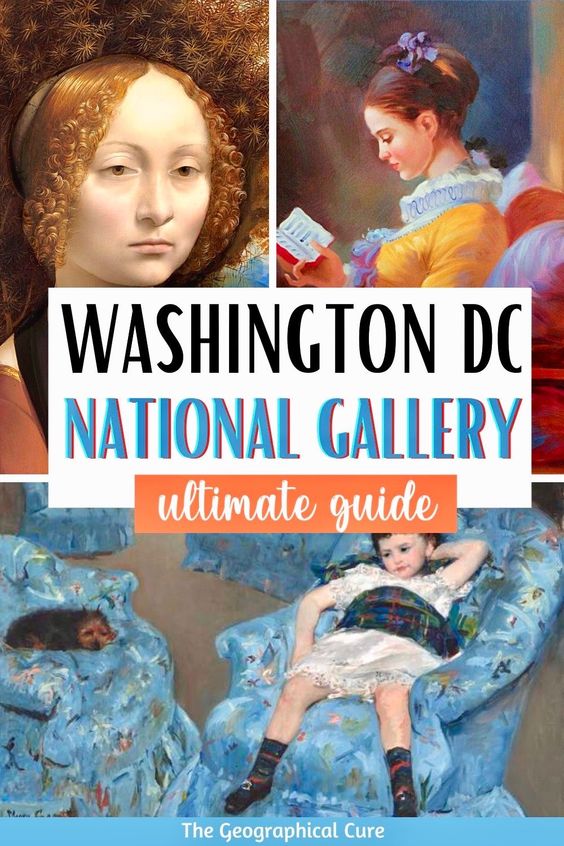The magnificent National Gallery of Art (“NGA”) in Washington D.C. is one of the world’s best museums. It’s a preeminent cultural institution with a massive and revered collection of American and European art.
In my opinion, the NGA is the #1 attraction in Washington D.C., especially for art lovers.
The museum opened in 1941. It’s young in comparison to other world class museums like the Louvre in Paris or the National Gallery in London.
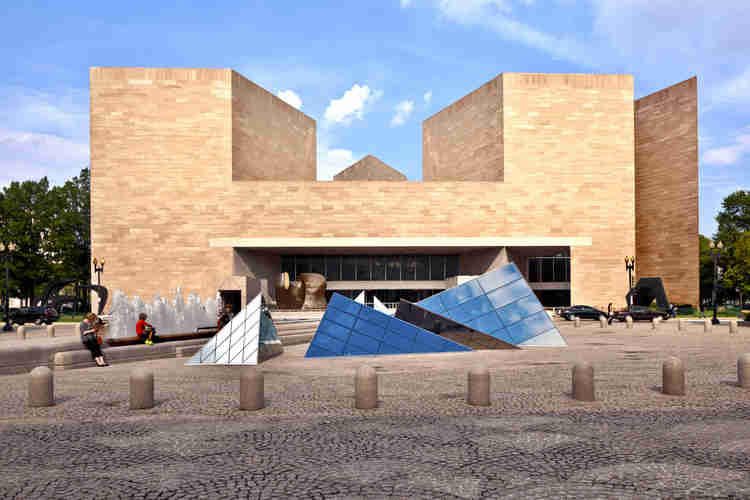
The collection is encyclopedic. The NGA is home to some of the world’s greatest masterpieces.
The collection includes over 140,000 paintings, drawings, prints, photographs, sculpture, and decorative arts from the 13th century to the present. The art ranges from Byzantine/Medieval altarpieces to Pop and Conceptual art.
The NGA also puts on spectacular temporary exhibits, which are also free. I just attended one of Vittore Carpaccio, a master of the Venetian Renaissance.
In this guide, I tell you everything to see at the NGA and how the museum is organized. My list includes 31 of the museum’s top masterpieces, from both the East Wing and the West Wing. I also give you must know tips for visiting the NGA.
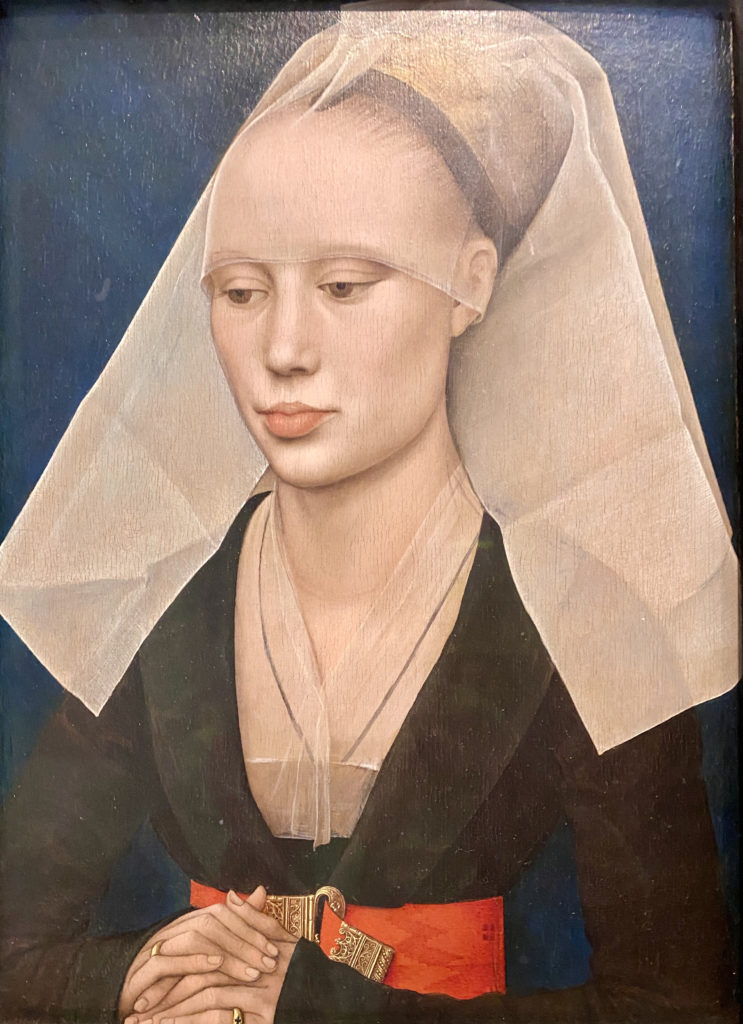
History of the National Gallery
Let’s start this NGA guide with a brief history of the illustrious museum. Did you know the National Gallery of Art was a gift to the U.S. from Andrew W. Mellon?
Yes indeed, the NGA was the brainchild of the wealthy industrialist. Mellon was inspired by the National Gallery in London. He funded construction of the West Wing.
Mellon also donated his large collection of paintings and sculptures. Those works include important pieces by Duccio, Van Eyke, Titian, Raphael, and Vermeer.
READ: Guide To the Famous Paintings of Raphael
IN 1939, the NGA received a large donation of Italian paintings from Samuel Kress. That same year, Philadelphia art collector P.A.B. Widener donated his collection. That included works by Rembrandt, Vermeer, Bellini, Titian, and a wealth of sculpture.
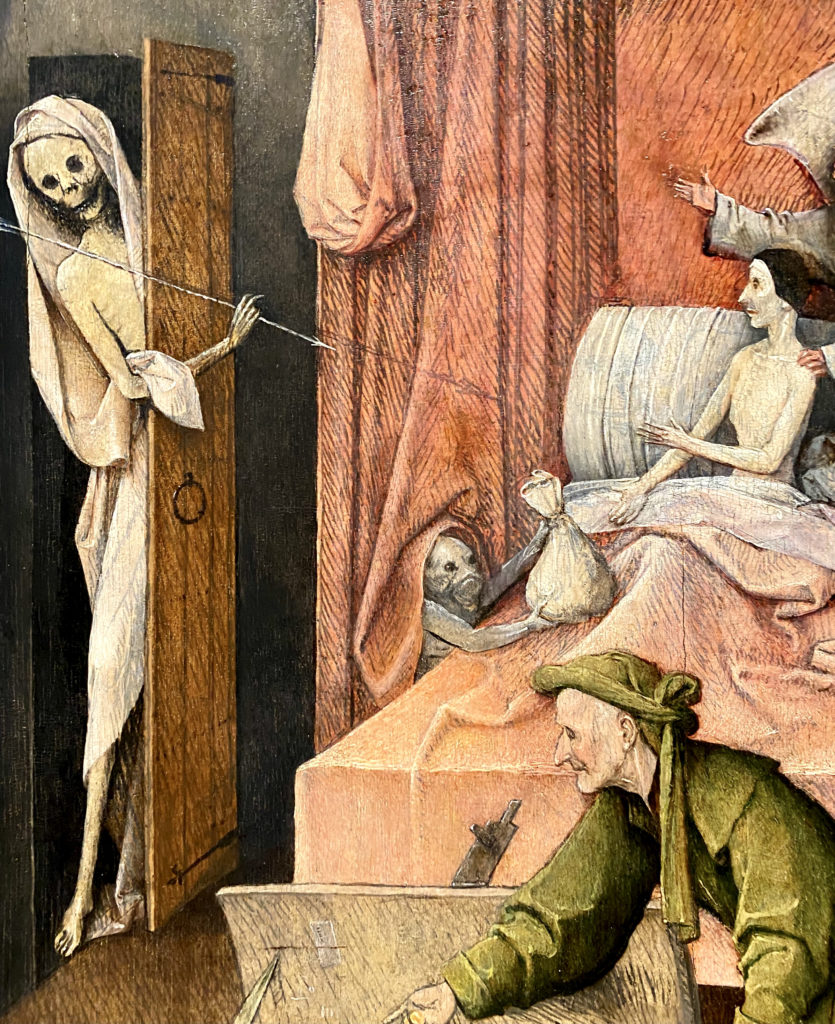
In 1941 and 1943, New York art collector Chester Dale donated an important cache of French and American art. These included works by Picasso, Manet, and the Impressionists.
READ: Impressionism Trail in Paris
Mellon’s children also became benefactors of the museum. His daughter Ailsa donated funds that led to the purchase of Leonardo da Vinci’s Ginevra de’ Benci. This is the only painting by Leonardo da Vinci in the United States.
Alison and Paul Mellon provided funding to construct the NGA’s East Wing, which opened in 1978.
The most important gift was Robert and Jane Myerhoff’s collection of contemporary and modern works, including works by Johns, Lichtenstein, Oldenburg, and Stella.
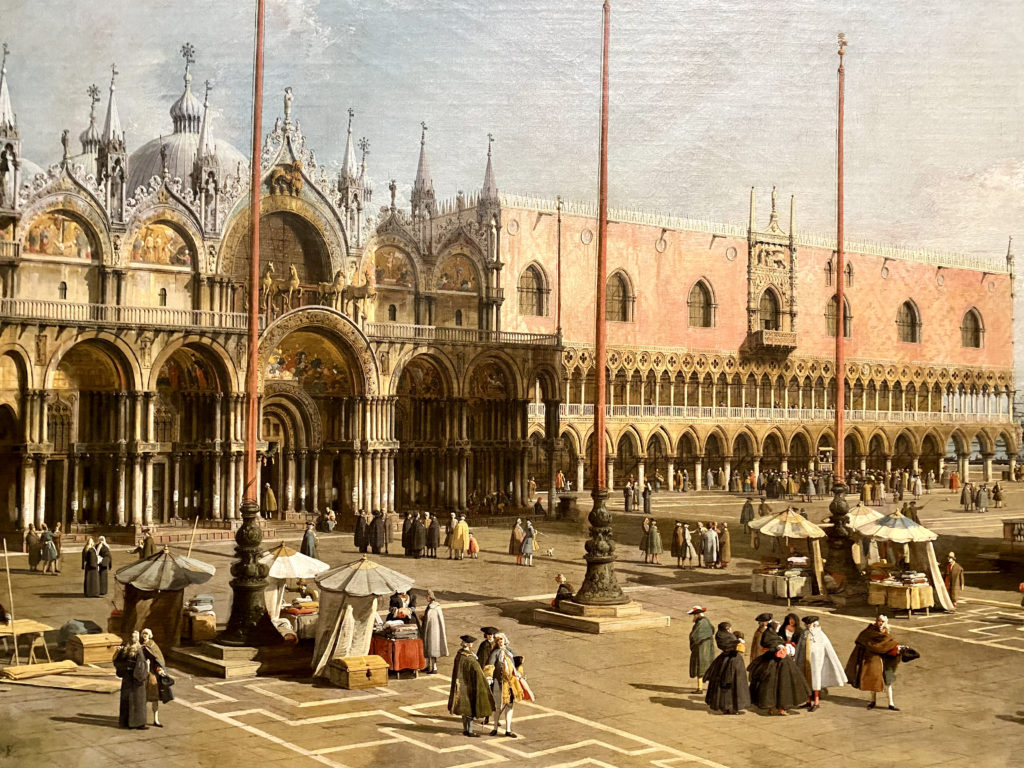
Overview of the National Gallery of Art
The NGA is a two part collection. It’s comprised of a West Wing and an East Wing. The West Wing was founded in 1937.
It’s housed in a beautiful Neo-Classical building, which was designed by John Russell Pope. The beautiful central rotunda was inspired by the Pantheon in Rome.
West Wing
The West Wing is massive. It’s the largest part of the museum. The main floor alone consists of 90 galleries.
The main floor houses European art from the 11th to century to the early 1900s and American art from the 18th and 19th centuries. It’s arranged in chronological order by art periods and national schools.
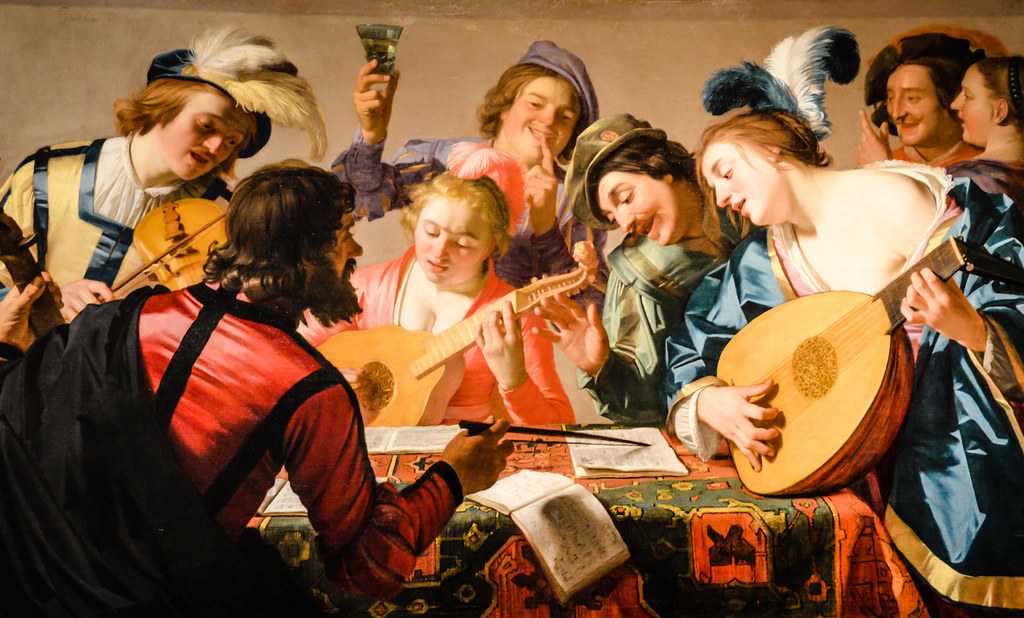
On the ground floor, you’ll find works by the Impressionists such as the famed Claude Monet and Edgar Degas (a whole room).
East Wing
The West Wing is connected to the East Wing by a remarkable walkway called Multiverse. It was created by Leo Villareal.
Multiverse is a futuristic moving underground tunnel. It comes complete with strobe lights.
Opened in 1978, the East Wing was designed by I.M. Pei. It’s completely different than the West Wing, with modernist sharp edges and geometric peaks.
The East Wing’s collection begins where the West Wing leaves off. It houses the NGA’s modern and contemporary collections. They cover the turn of the 20th century to the present day.
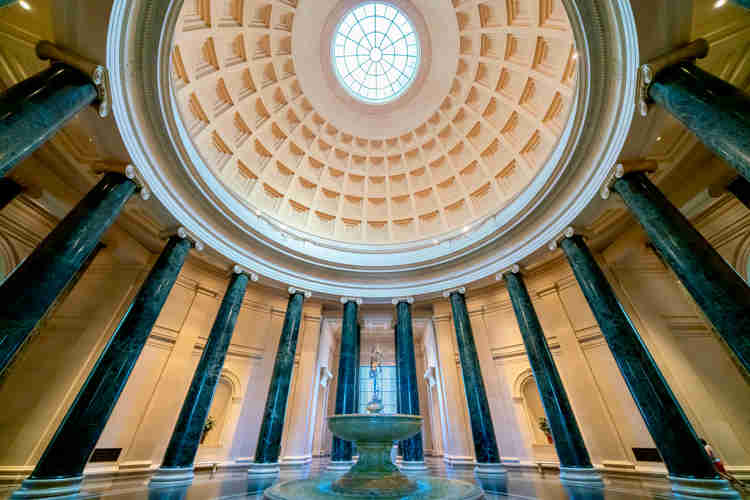
Mercury sculpture (after Giambologna) in the rotunda of the West Wing
Recently renovated, you’ll find airy galleries and a frame of glass pyramids in the atrium. You start in the Picasso era. Then, you’ll work your way through all the different phases of modernism — Dada, Surrealism, Abstract Expressionism, Fauvism, and Pop art.
There’s a room devoted to French modernism. Another is filled with rare Modigliani portraits.
There are two towers open to the public. One houses works by Barnette Newman and Mark Rothko. The other is home to stunning display of Alexander Calder’s mobiles suspended from the ceiling.
After climbing the tower, head outside to the roof terrace. There, you’ll find the iconic 15 foot high Blue Rooster by Katharina Fritsch.
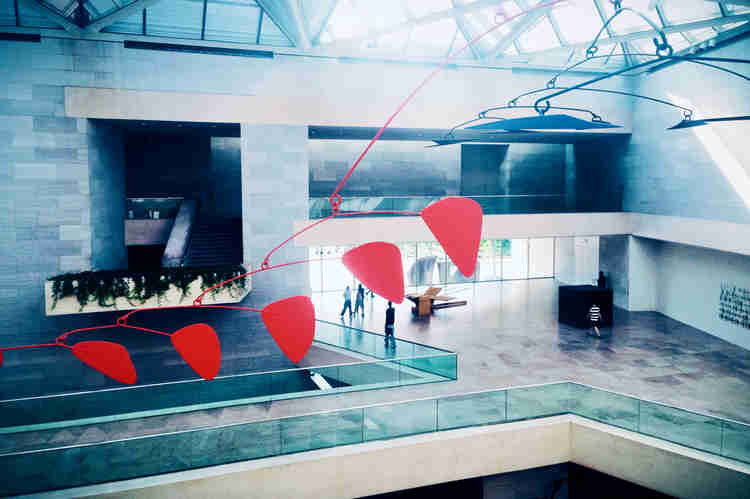
Alexander Calder monumental mobile in the East Wing
There’s also a free sculpture garden outside the museum. The fountain in the center is turned into a ice skating rink in winter.
To prepare for you visit, you can start browsing the gallery’s vast collection via the NGA Images website. You can sort by artist, title, and date. The NGA has digitally archived 45,000 works of art that are available to browse and download for free.
READ: Tips on How To Visit a Museum
Guide To The National Gallery of Art: What To See
So what can’t you miss at the NGA? The museum has such a magnificent cache of treasures, you won’t be able to see everything.
Here are my picks for 31 masterpieces you can’t miss at the NGA. I include 16 from the West Wing and 15 from the East Wing.
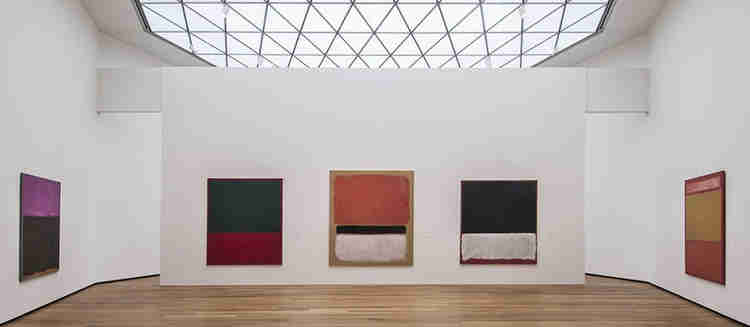
East Wing Masterpieces
1. Mark Rothko Room, Tower 1
There’s a room full of Mark Rothko works in tower 1 on the mezzanine level. Rothko was one of the founders of Abstract Expressionism. They were a loose-knit group of painters who made New York City the center of the art world.
Unlike Jackson Pollock and Willem de Kooning, who both wielded the brush with great energy, Rothko painted softly edged rectangles of color. His works were at once veiled, moody, and radiant.
This style would define Rothko’s work for his last two decades. Rothko did not identify himself as a colorist. Rather, his goal was to express the basic human emotions of “tragedy, ecstasy, doom.”
2. Pablo Picasso, Family of Saltimbanques
This Picasso painting is front and center as you enter the mezzanine. Picasso was probably the greatest artist of the 20th century.
His art evolved over time. His work is separated into the Blue Period, Rose Period, Neoclassical Period, Surrealism, and Cubism.
The NGA own’s Picasso’s great Family of Saltimbanques, the most famous painting from his Rose Period. This is one of Picasso’s early masterpieces.
It’s a multi-figure composition with autobiographical overtones. It shows a group of marginalized circus performers. Picasso had just moved from Spain to Paris, and also felt like an outcast.
He was impoverished and lived with other striving artist in Montmartre. Back then, Montmartre was a seedy area. Now, it’s is now a chic Parisian neighborhood.
READ: Guide To the Picasso Museum in Paris
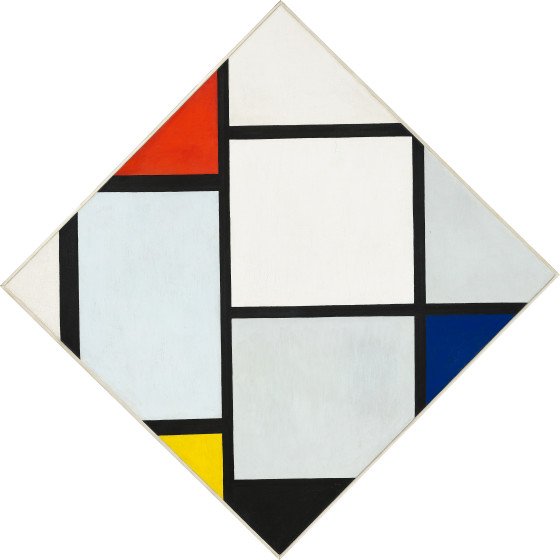
3. Piet Mondrian, Tableau IV
Piet Mondrian was one of the founders of the Dutch De Stijl modern art movement. He’s known for his radically simplified paintings and pure abstractions.
His best known paintings are in his classic Neo-Plastic style from the 1920s. In that decade, he dramatically reduced his shapes to basic lines and rectangles.
Mondrian used a pared down palette of primary colors and black and white. This tactic, he claimed, was designed to better convey “universal truths.”
This piece is the largest of Mondrian’s 16 “diamond” paintings. He executed these works between 1918-44. He tried to prevent any form from being too comfortable to look at, a concept he called “dynamic equilibrium.”
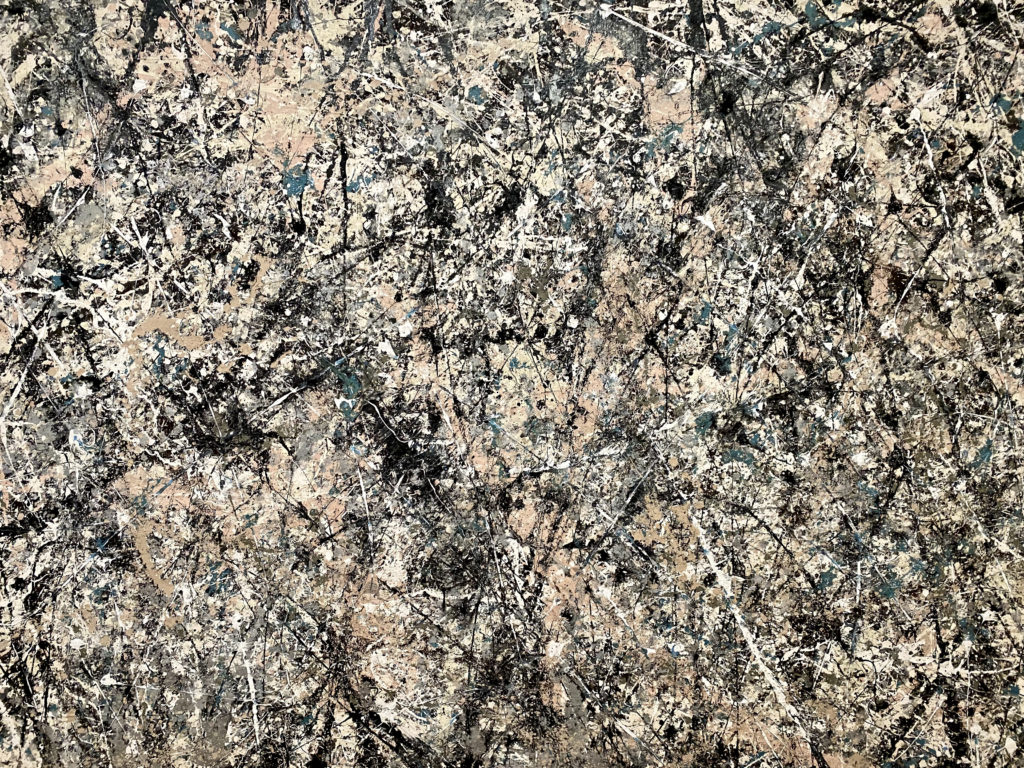
4. Jackson Pollack, Lavender Mist
Pollack was a NYC-based Abstract Expressionist painter. He’s most famous for inventing the drip technique of painting.
Starting in 1947, Pollack would drip, dribble, and pour paint on canvases on the floor. This technique created an immersive experience for the viewer.
Lavender Mist was created in 1950. It’s one of four of his exceptionally large canvases. He created it in his studio-barn on Long Island.
The painting has streaks and webs of black, teal, olive, peach, cream, silver, and gray paint.
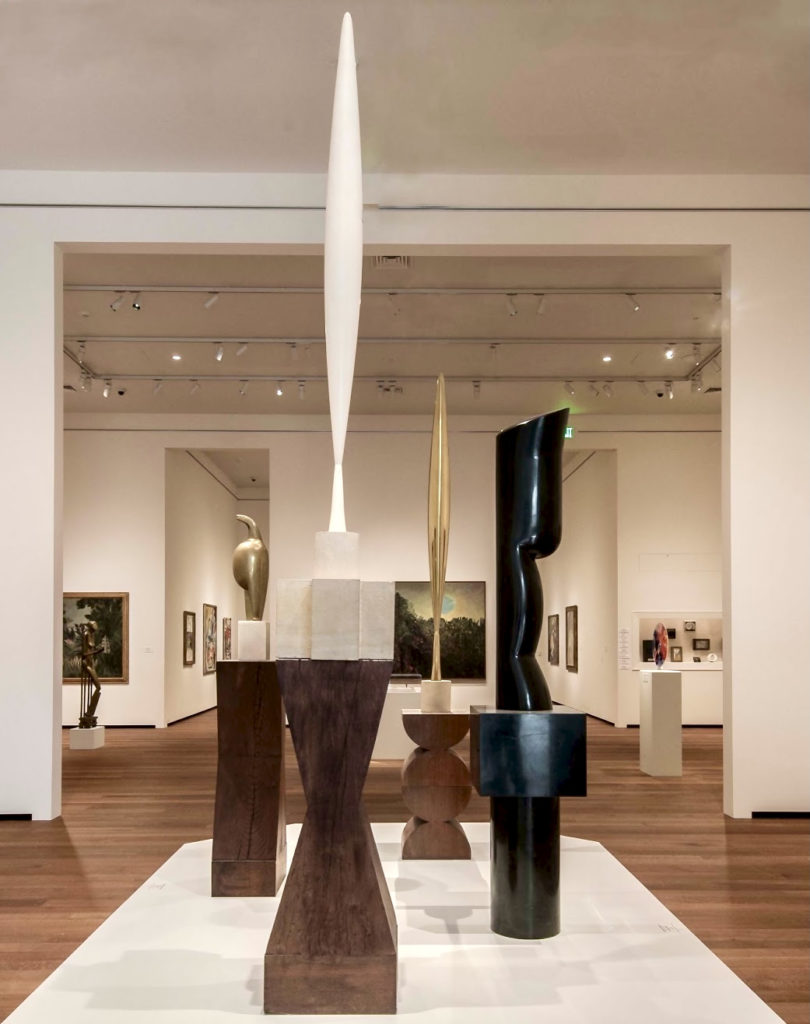
5. Brancusi, Bird in Space
Brancusi was a Romanian artist, who allegedly arrived in Paris on foot. There, he studied at the Ecole des Beaux Arts and briefly worked in Rodin’s studio.
Brancusi revolutionized sculpture. He is often regarded as the most important sculptor of the 20th century. His works depict idealized and abstracted representations of his subject matter.
Bird in Space is one of the artist’s most iconic series and lifelong passions. In these intensely polished works, Brancusi dispensed with the bird’s physical attributes.
Instead, he focused on capturing “the essence of flight.” Brancusi used elongated, tapering figures that suggest upward movement.
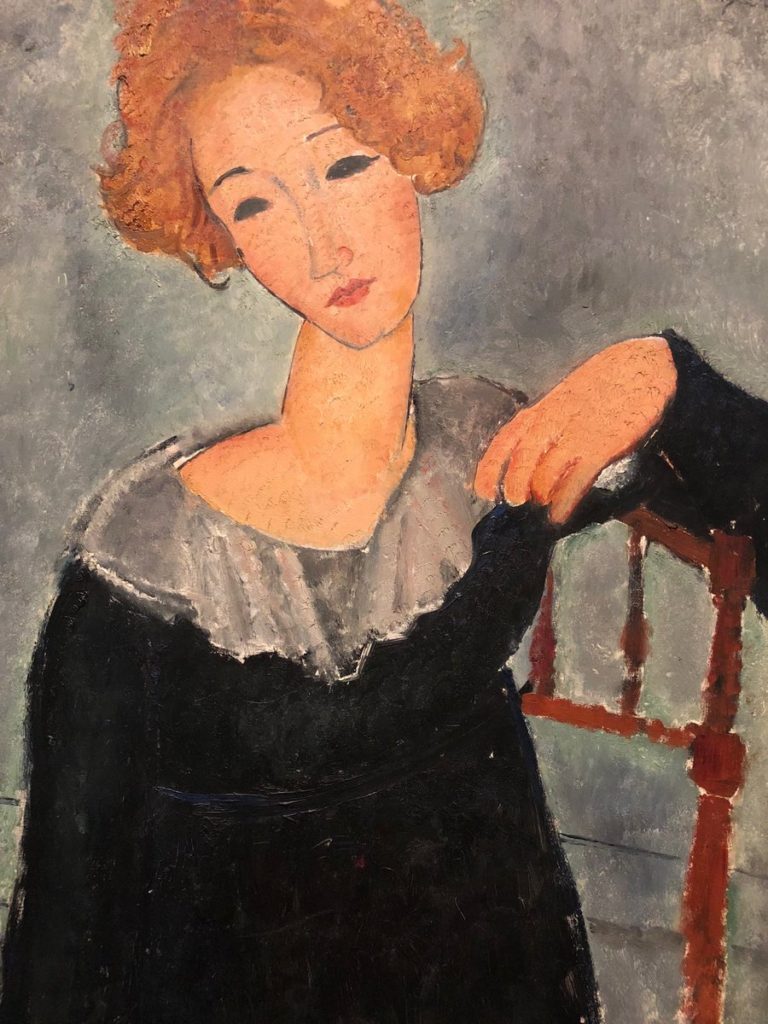
6. Modigliani Room
There’s an amazing room in the East Wing with 11 paintings and a head sculpture by Amedeo Modigliani.
Modigliani painted in fin-de-siecle Paris, along with Picasso and other impoverished artists in Montmartre. He died penniless of an early death caused by sexual debauchery and drug and alcohol addiction.
Modigliani is most famous for his portraits. They all feature a certain melancholy.
His subjects have elongated limbs, mask-like faces, and slitted eyes. His nudes (2 in the room) scandalized society with their graphic depictions and candid sexuality.
Woman with Red Hair is likely an early portrait of his bohemian partner, Jeanne Hebuterne. She committed suicide upon his death. The image is of a modern woman, with unusual short hair for the day. She also wears lipstick and rouge.
The image is both careful and messy. The face is finely drawn. But the paint appears smashed on in places.
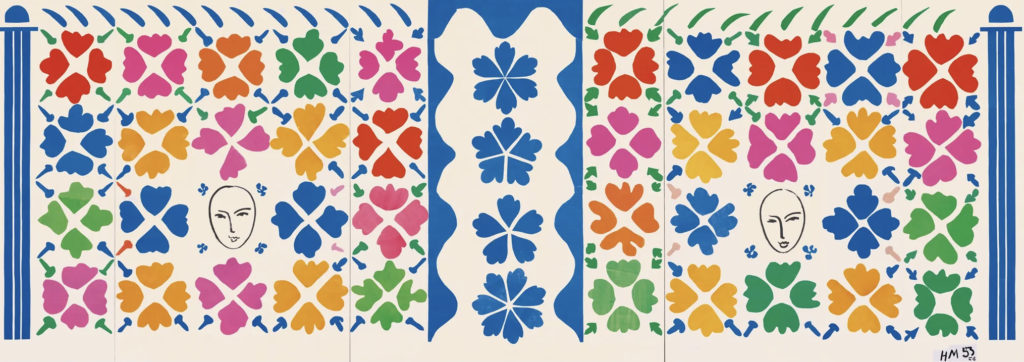
7. Henri Matisse, Large Decoration With Masks
Henri Matisse is widely regarded as the greatest colorist of the 20th century. He had a staunch rivalry with Picasso. Matisse first emerged as a Post-Impressionist. Later, he became a leader of the Fauves.
In his later years, his eyesight faded. Matisse began producing a series of collages using cut-out shapes of color.
Large Decoration with Masks is one of his massive cutouts. It was inspired by the Moorish decorations of the Alhambra palace in Granda Spain. His assistants took sheets paper saturated with color.
Matisse attacked them with his scissors. He cut them into lyrical shapes. Matisse then told his assistants how he wanted them placed on the wall.
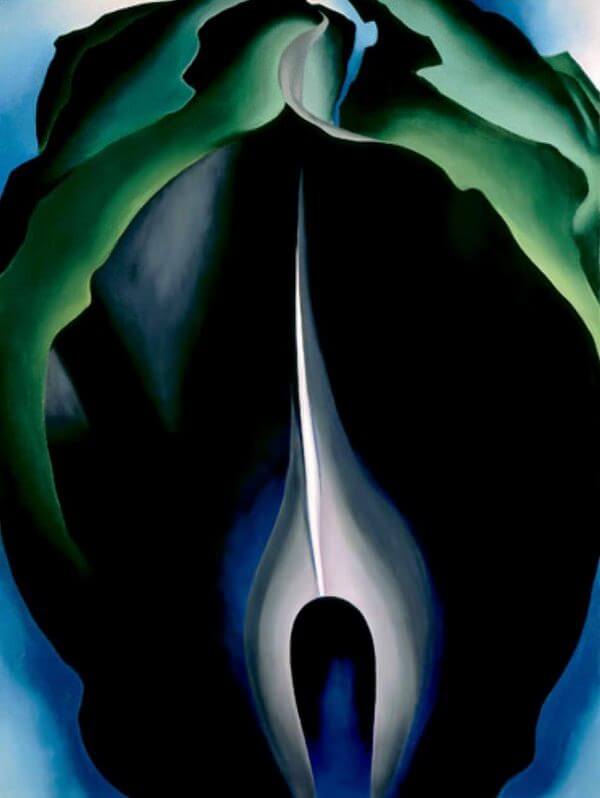
8. Georgia O’Keeffe, Jack-in-the-Pulpits
Georgia O’Keeffe played a key role in the rise of Modernism in the United States. She was an American artist inspired by nature. She sought to capture the emotion and power of objects and natural elements.
In 1930, she began spending time in Taos New Mexico to get away form the NYC art world. There, she produced her iconic Jack-in-the-Pulpit paintings.
The NGA is home to five of her six Jack-in-the-Pulpit paintings. The artist gifted them to the museum. No. IV is shown above. No. IV focuses on the cavernous, dark purple interior of the flower, rendering it abstractly.
Art critics thought she was depicting female anatomy. But O’Keeffe always denied this theory.

9. Andy Warhol, A Boy for Meg
Warhol essentially launched pop art. Warhol was a true iconoclast and performance artist. He was a hugely significant artist of the second half of the 20th century.
Warhol challenged traditional norms of what constituted art. He was unashamedly obsessed with beauty and fame. Warhol tried to capture the duo in a shocking way.
Warhol’s A Boy For Meg is drawn from the 1961 front page of the tabloid rag the New York Post. It reflects Warhol’s fascination with celebrity and consumer culture.
The art work is based on a photograph of the headline-making Princess Margaret of England. The headline announced the birth of her son.
READ: Guide To the Warhol Museum in Pittsburgh
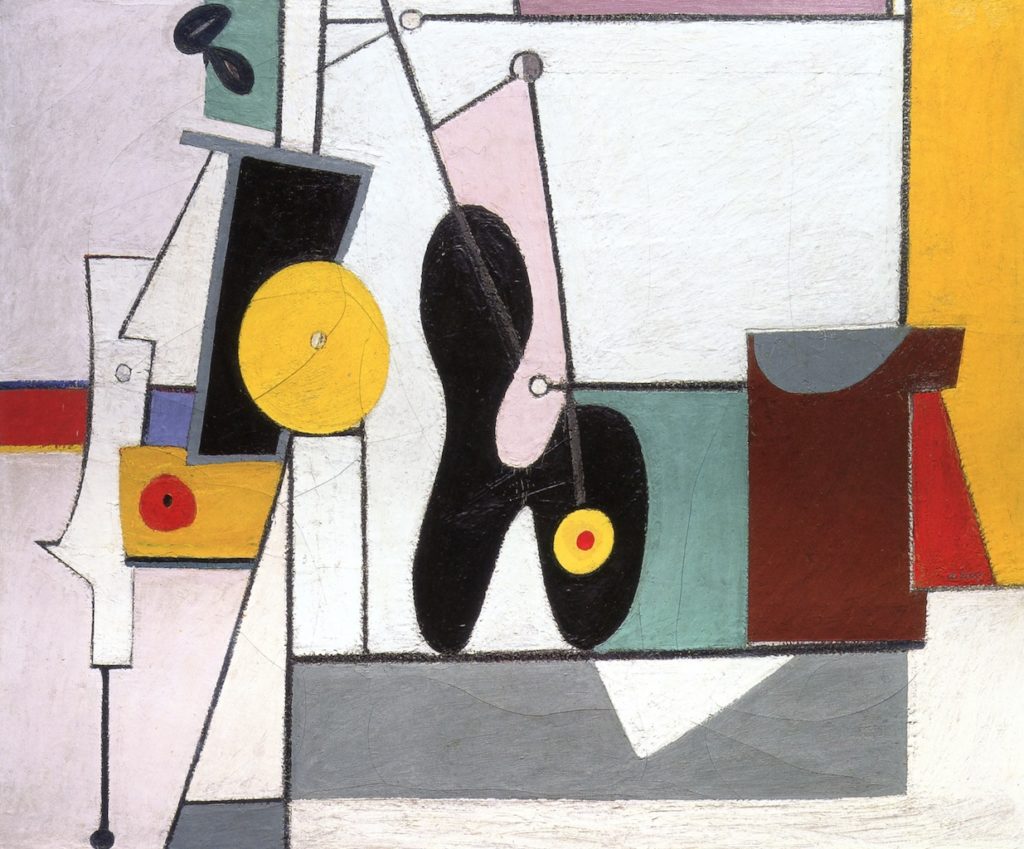
10. Arshile Gorky, Organization
Gorky was an important Armenian American artist. He led the way toward the development of Abstract Expressionism in NYC.
Gorky used biomorphic shapes, like Joan Miro. But Gorky gave the abstract figures freer form.
In Organization, Gorky attempts to harmonize the diverse works of Picasso (Cubism), Mondrian (Minimalism), and Surrealism (motifs of Miro).
This amalgamation in Organization took him 4 years to create the work. While abstract, his forms were inspired by nature.
The work broke a logjam in Gorky’s career. Later, his works were characterized by a more spontaneous lyrical outpouring.
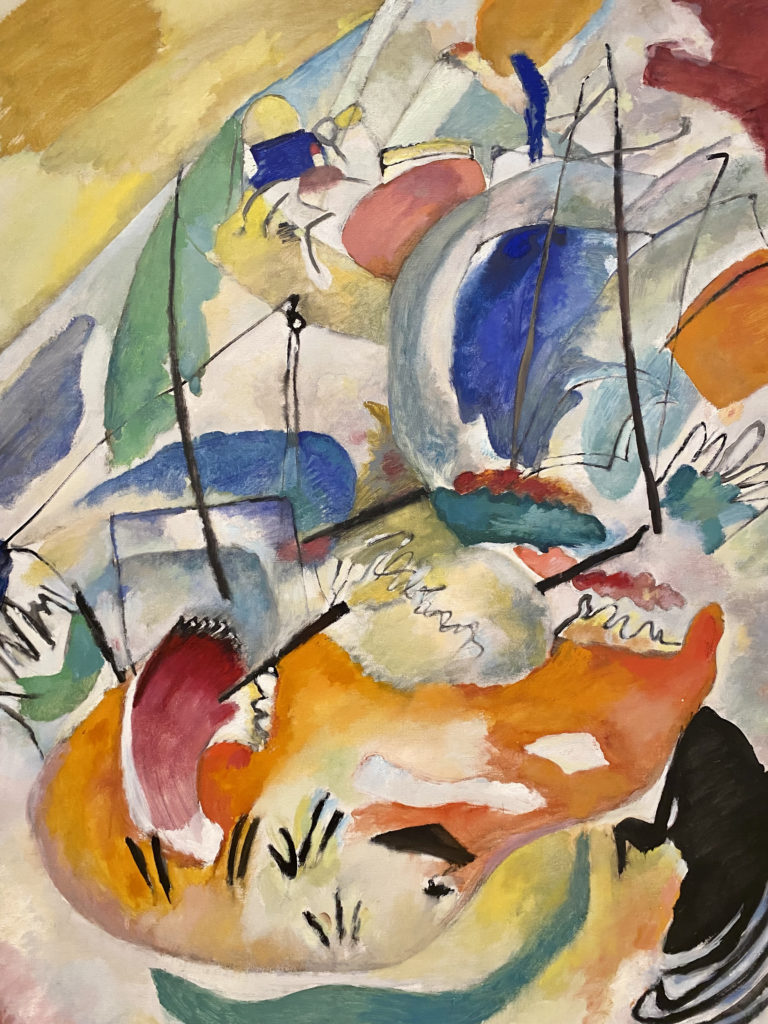
11. Wassily Kandinsky, Improvisation 31
Kandinsky lays claim to being one of the inventors of abstract painting, just before WWI. He believed that non-objective art was the best means to express the “inner necessity” of the artist and to convey universal human emotions.
Improvisation 31 is almost completely abstract. It has mostly amorphous shapes and patches of color.
The term “Improvisation” referred to a series of works Kandinsky painted between 1909 and 1913. According to the artist, they were intended to portray a spontaneous image of his inner spirit.
You have to inspect the painting fairly closely to make out its central theme — two ships locked in combat. But there are images of cannons, ships, and waves.
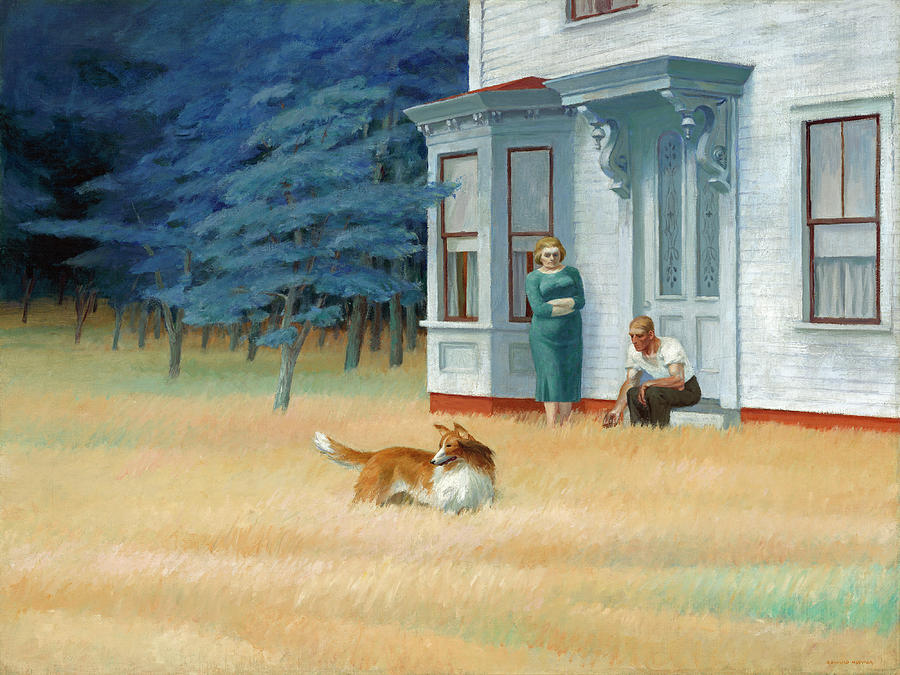
12. Edward Hopper, Cape Cod Evening
Hopper was a master at capturing an individual within the setting of an bleak urban city. His works fall with the rubric of realism. But they are more minimalist and enigmatic.
Edward Hopper painted Cape Cod Evening in 1939 in Truro. It’s a small fishing village in Massachusetts. The painting has a dissonance typical of his work.
Several elements of the tableaux are disturbing. The man and woman are self-absorbed. They seem oblivious to each other’s presence.
The long uncut grass and wild blue trees contrast with the well-maintained house. The collie’s pose seems to portend a threat. It suggests a clash of nature and culture.
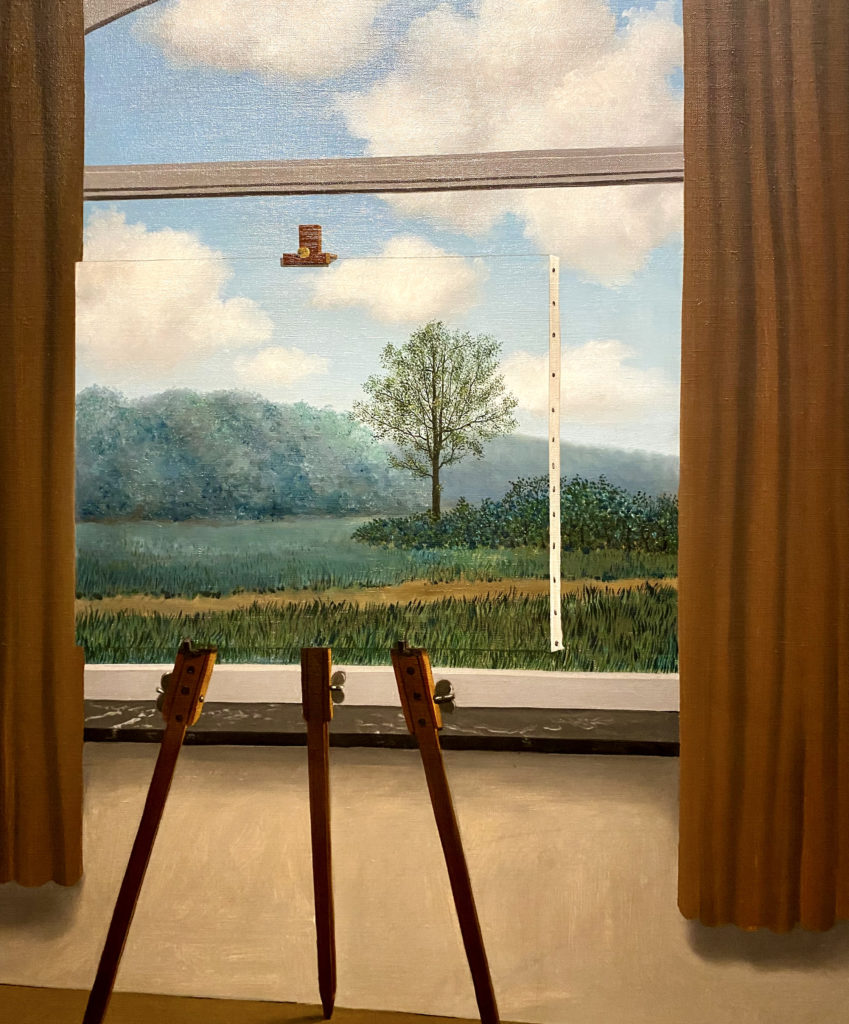
13. Rene Magritte, La Condition Humaine
Belgium artist Magritte was a Surrealist painter. But he had an idiosyncratic oeuvre.
Magritte adopted a deadpan, illustrative technique. Having earned a living in commercial art, some of Magritte’s paintings have the abbreviated impact of an advertisement.
Magritte’s paintings were paradoxical. A simple image could evoke unsettling thoughts. His works seem to declare that they lacked any mystery. Yet, they are also marvelous hints of the strange, as if you need to peel away endless layers.
In La Condition Humaine, a painting on canvas overlaps with the landscape outside the window. The left edge overlaps the left side of the curtains.
There are frames everywhere, though the paintings itself is unframed. It’s an interesting illusion.
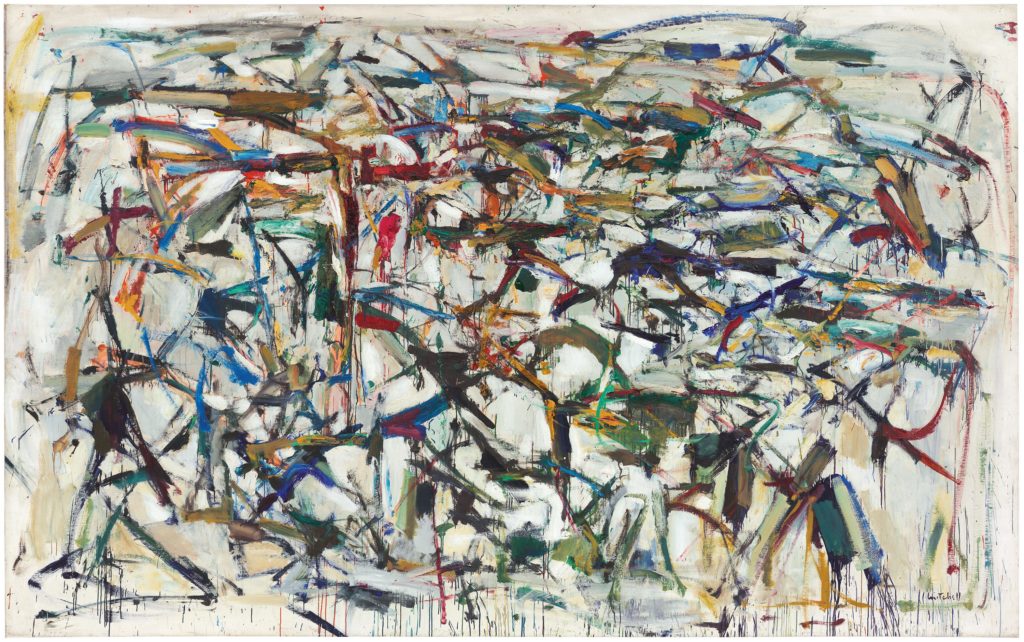
14. Joan Mitchell, Piano Mécanique
Joan Mitchell was a second generation Abstract Expressionist with a unique style. She was one of few women to establish herself in the macho male-dominated world of the Abstract Expressionists.
Mitchell saw people and things in color. She worked from her own mental images. Mitchell attacked painting with slashing long strokes and explosions of paint.
She was not a drip painter like Pollack. But she nonetheless allowed thinned paints to seep into dangling strings. Her paintings have a kind of physicality.
Piano Mécanique combines the slashing strokes of de Kooning and the all-over painting structure of Pollack. It’s what Mitchell called one of her “remembered landscapes.”
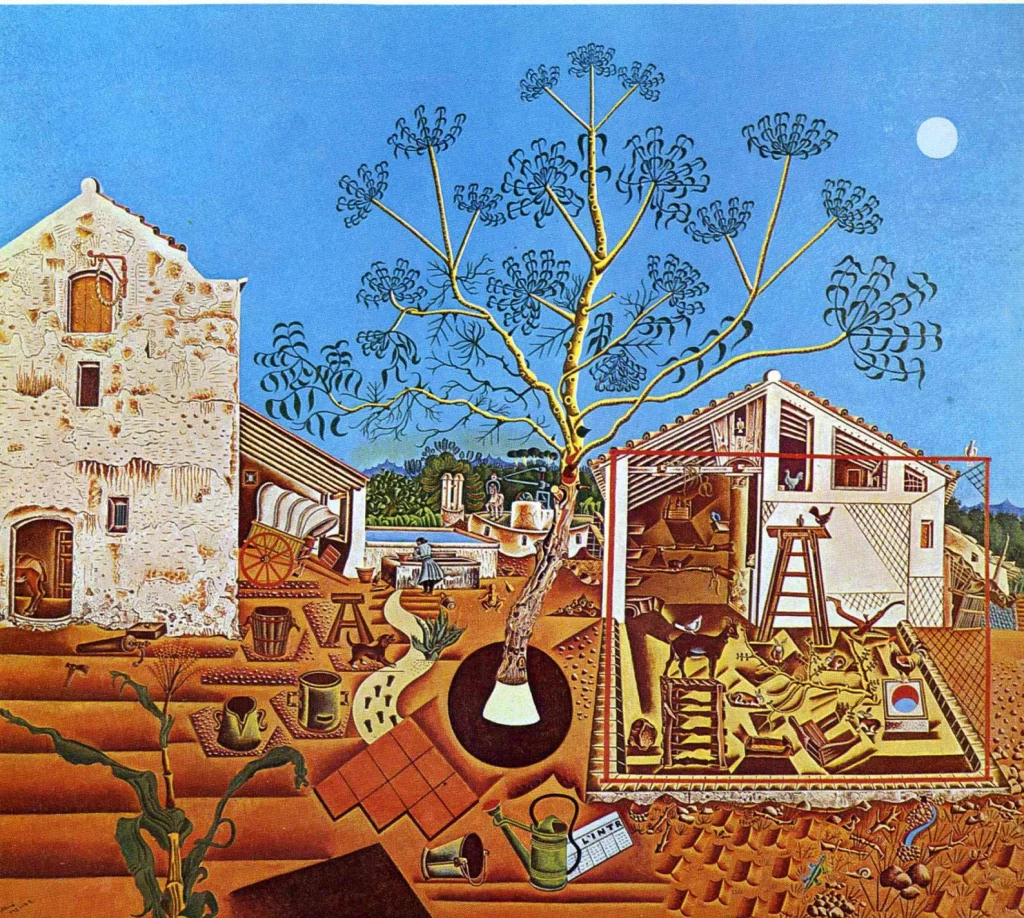
15. Joan Miro, The Farm
Miro is a Surrealist artist from Barcelona Spain, noted for his colorful and lively biomorphic paintings and sculptures. The non-objective forms on his canvases represented a sandbox for his subconscious mind.
Miro used his own interior emotion to drive abstract expression. He had a profound influence on the Abstract Expressionists.
In this early Miro piece, the painting is suffused with detail. It gives a slight nod to Cubism and may anticipate Surrealism by a few years. The painting gained fame when it was purchased by Ernest Hemingway.
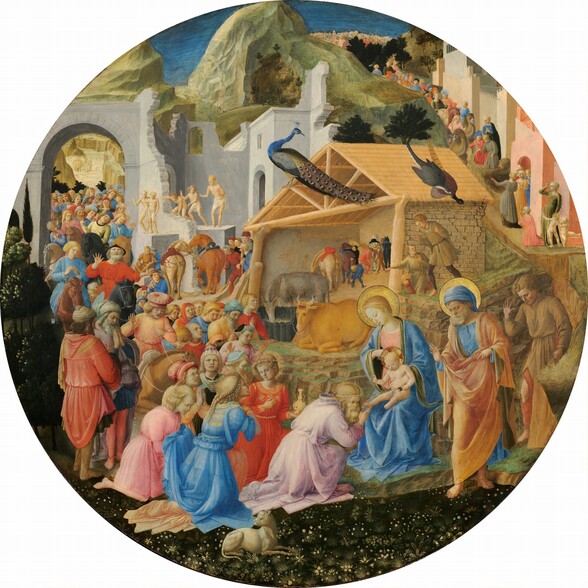
West Wing Masterpieces
Now, we turn to the must see art in the West Wing of the NGA.
1. Fra Angelico and Fra Filippo Lippi, Adoration of the Magi
Fra Angelico painted in the mid 1400s. He lovingly created sacred art with realistic down to earth images of humans and human emotions.
With Giotto and Donatello, Fra Angelico helped transform the art world and usher in the High Renaissance.
His humanistic pieces had delicate palettes. This led him to be (posthumously) dubbed the “Angelic Painter” or Il Beato (the Blessed).
Art historian Giorgio Vasari described Fra Angelico as a “rare and perfect talent.” He was one of the extraordinary figures of the Renaissance.
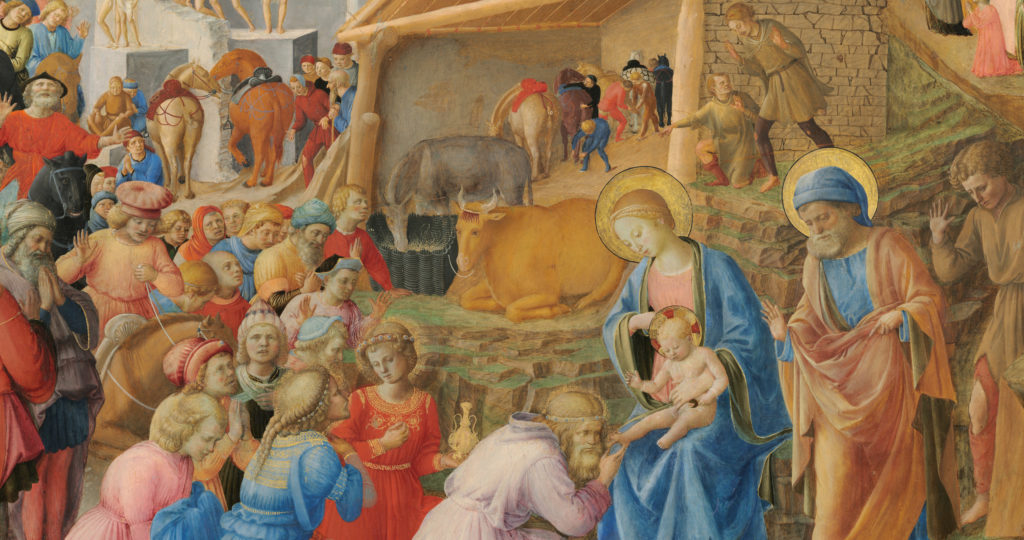
READ: Guide To Florence’s San Marco Monastery, a Fra Angelico Dreamland
This beautiful painting used to reside in one of the Medici palaces in Florence. It depicts the Adoration of the Magi.
That is the moment when the Three Kings, led by a miraculous star, came to adore the Christ child. You can see Fra Angelico’s contribution in the delicacy of the faces.
After his death, some 20 years later, Fra Filippo Lippi, who was then the Medici favorite, likely completed the commission.
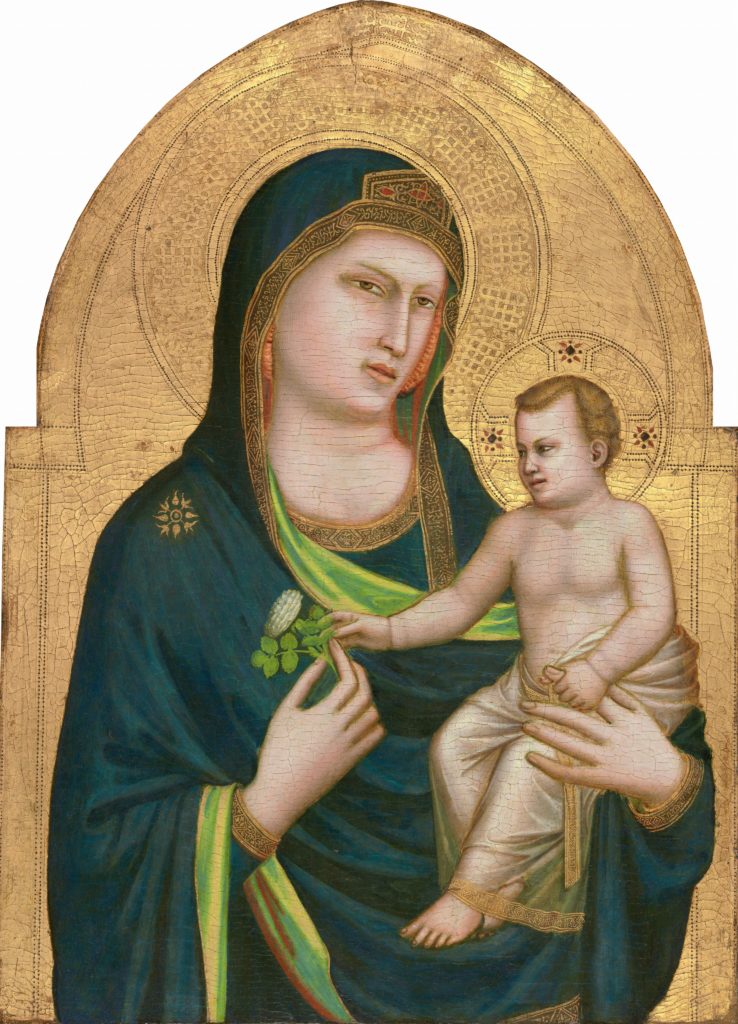
2. Giotto, Madonna and Child
The Florentine artist Giotto was the preeminent painter of the Early Renaissance. Giotto’s paintings were radical at the time.
READ: Guide To the Masterpieces of Florence
He was the first artist to break away from stylized and formulaic style of medieval art. He ditched the gray and gold religious iconography and used vivid colors.
More importantly, Giotto painted real people in 3D scenes from everyday life. He replaced the mask-like faces prevalent in Gothic art with expressive faces.
In this painting, Giotto’s madonna exudes emotion and a sense of seriousness. She holds the Christ child and presents him with a rose.
READ: Guide To Giotto’s Scrovegni Chapel
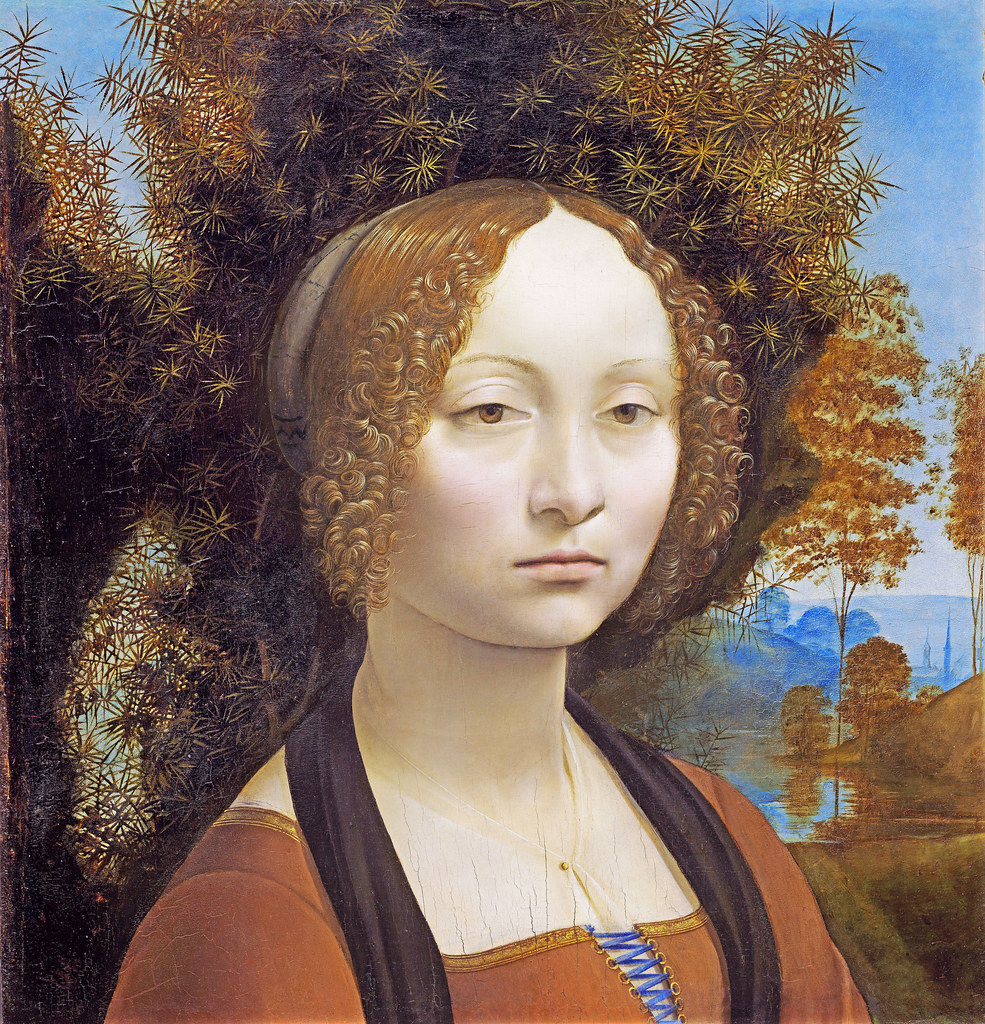
3. Leonardo da Vinci, Ginevra de’ Benci
Ginevra is an early Leonardo portrait and the most important painting in the NGA. Scholars think it’s possibly an engagement portrait.
Ginevra is the only Leonardo painting in the United States. She’s nicknamed the “Washington D.C. Mona Lisa.”
Ginevra represents a watershed in Italian Renaissance portraiture. And seeing her is a far superior experience than seeing the Mona Lisa at the Louvre. You can admire this famous Leonardo painting without hordes of people.
Ginevra was the teenage daughter of a wealthy Florentine banker. The portrait is one of Leonardo’s early experiments with the new medium of oil paint and psychological elements.
The 3/4 pose is an Italian Renaissance first. Ginevra’s face is translucent. While a bit severe, it’s characteristic of a new naturalism that would pervade the Renaissance.
At that time, it was rare for a woman to look at the viewer. But for the first time in art history, Leonardo’s Ginevra looks directly at you. She’s even incorporated into her own landscape.
Departing from precedent, Leonardo placed Ginevera in an open setting, rather than a stuffy sheltered room in her home. The shimmering blue landscape isn’t just a backdrop. Leonardo makes it a living thing.
READ: Guide To All Of Leonardo da Vinci’s Paintings
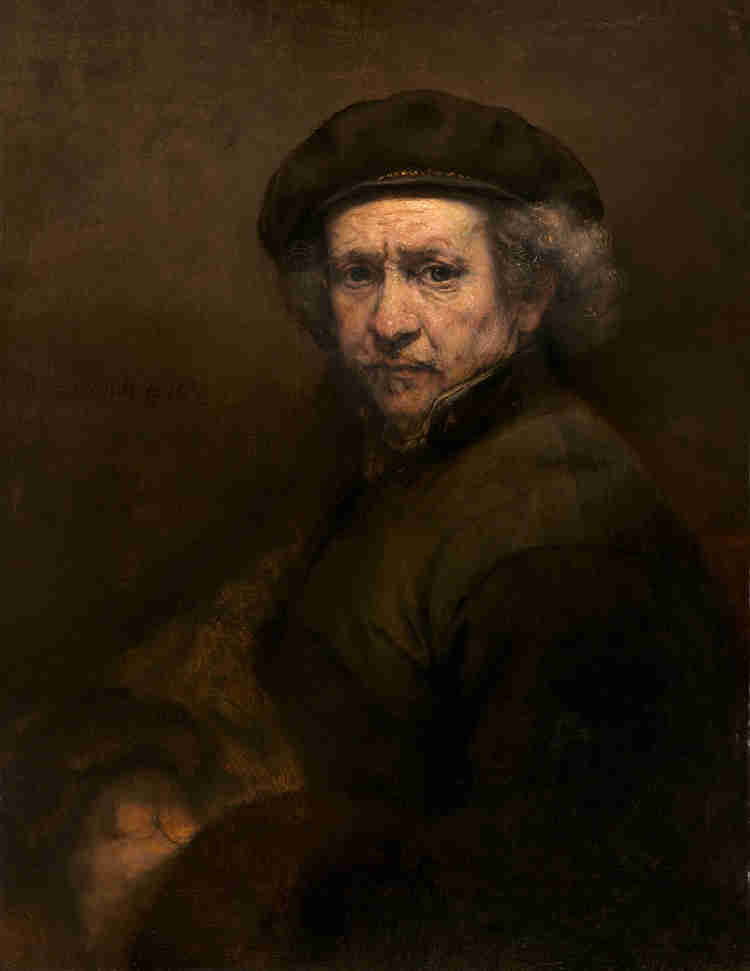
4. Rembrandt Room
There are a fair number of Rembrandts grouped in the rooms of the Dutch Baroque period. The most famous painting is this Self Portrait.
Rembrandt was famous for his numerous self portraits. They give a chronicle of his physical appearance, which is unique for artists.
This portrait was painted at a dire time. Rembrandt had just declared bankruptcy. He looks weary, but not despondent.
Rather, he shows an inner strength and dignity. The light focuses on his face with deep set eyes.
The portrait’s pose is modeled after Raphael’s famed portrait of Balthasar Castiglione in the Uffizi Gallery. Other Rembrandts in the museum include The Mill, View Over Amstel from the Rampart, Christ Crucified between the Two Thieves, and the beautiful Lucretia.
READ: Guide To Florence’s Uffizi Gallery
5. Raphael, Alba Madonna
This beautiful painting is a mature work by Renaissance superstar Raphael. It’s in a round tondo, a form that was popular at the time.
This painting is stunningly beautiful. Mary looks almost like a Roman figure, with sandals.
She, Christ, and John the Baptist are arranged in a pyramidal composition. They all look at the cross. The group is set against a bucolic landscape of Tuscany.
There’s a monumentality and force to this painting that wasn’t present in Raphael’s earlier works. The painting is also full of symbolism.
A radiant Mary is shown wearing a blue mantle and blue sandals, representing the church. Her red dress and the tiny cross represent Christ’s sacrifice.
READ: Guide To Raphael’s Most Famous Paintings
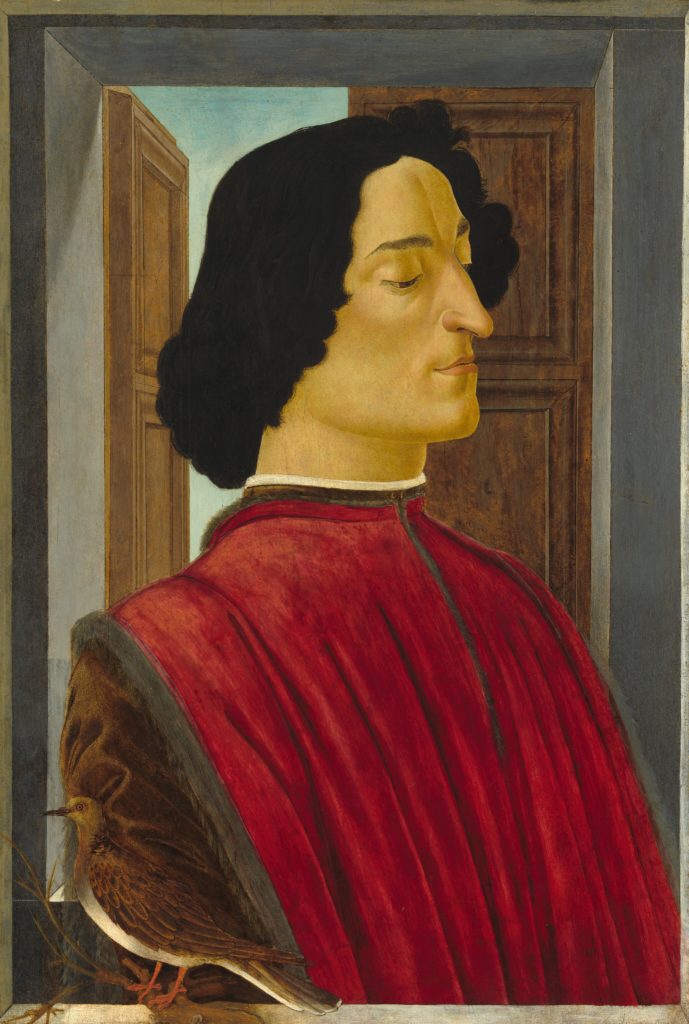
6. Sandro Botticelli, Giuliano de’ Medici
Sandro Botticelli is one of the premiere Early Renaissance painters. You probably know him best for his Birth of Venus in the Uffizi Gallery in Florence Italy.
In this portrait, Botticelli portrays the brother of the great Lorenzo the Magnificent. Lorenzo was the de facto ruler of Florence.
His brother Giuliano has murdered in Florence Cathedral during the Pazzi Conspiracy in 1478. This portrait became the prototype for other posthumous depictions of Giuliano.
In this one, Giuliano is portrayed almost like a saint-like figure. The bird and the open window symbolize his passage into the afterlife.
In the same room is a painted terracotta bust of his brother Lorenzo. There’s also another lovely Botticelli, The Adoration of the Magi.
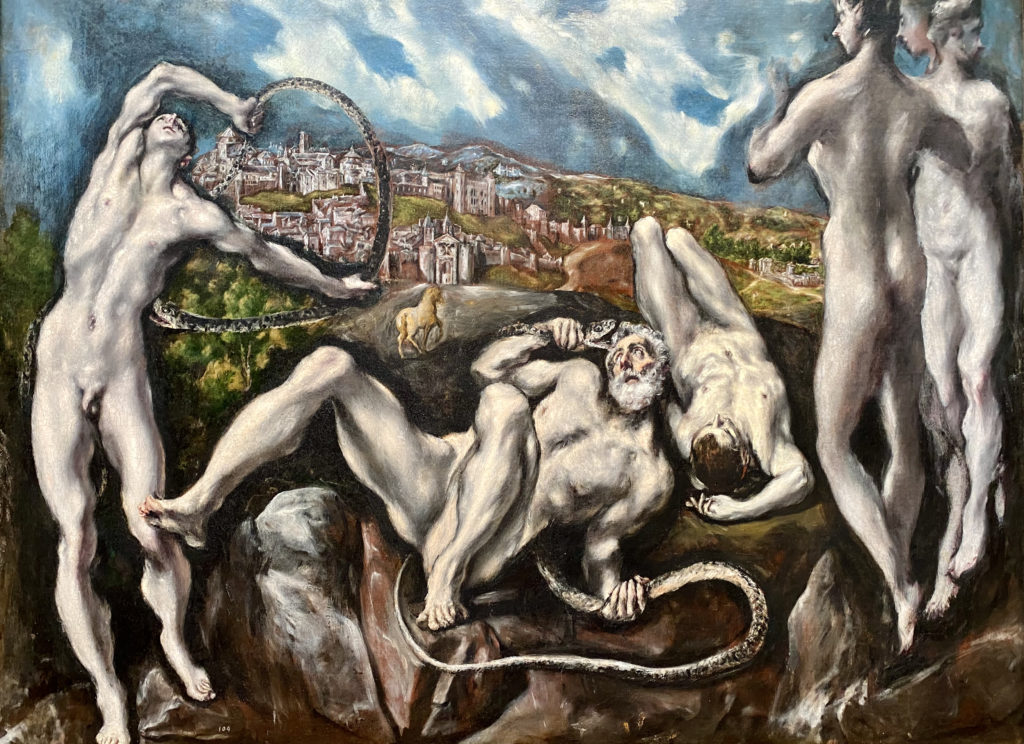
7. El Greco, Laocoon
Part of the “Golden Age” of Spanish painting, El Greco is a famous Greek painter. Born in Crete, he settled in Toledo after training with Renaissance giant Titian in Venice.
El Greco was a Mannerist painter. He was known for his malleable and elongated figures.
El Greco’s figures are rendered with unreal acidic colors and fluid distortions of the body. El Greco was considered a “painter of the spirit.”
Laocoon is El Greco’s only surviving mythological painting. It’s based on the famed Laocoon sculpture in the Vatican Museums.
The painting depicts the Trojan priest Laocoon in curing the wrath of the gods when he warned his countryman not to accept the wooden horse from Troy. As punishment, the gods sent serpents to kill Laocoon and his sons.
READ: One Day Itinerary for Vatican City
El Greco depicts the drama in bold brushwork and contorted bodies. There’s a stark contrast of light and dark. The scene is set against a moody cityscape of El Greco’s home town of Toledo.
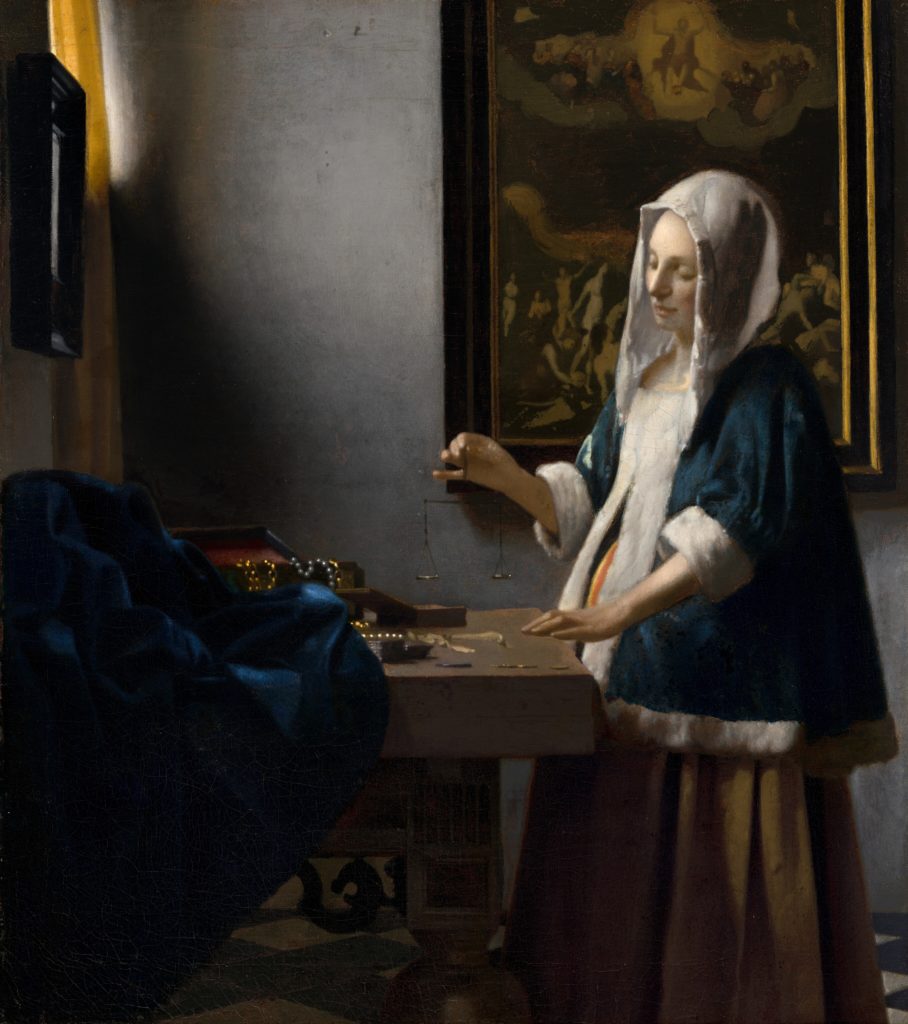
8. Vermeer, Woman Holding a Balance
Vermeer was one of the premiere painters of the Dutch Golden Age. There are very few Vermeer paintings in the world.
This one demonstrates his trademark sense of rhythm and stability. In the painting, a graceful woman in a fur trimmed coat introspectively contemplates a set of balance scales. She’s illuminated solely by the window light, in an almost ethereal way.
Her earthly treasures of gold and pearls lie on the table. A painting of The Last Judgment is behind her. The painting is a morality tale. It allegorically suggests that a life of temperance is ideal.
There’s another Vermeer painting too, one of his smallest. It’s called Girl with the Red Hat. The painting shows off Vermeer’s exquisite use of color.
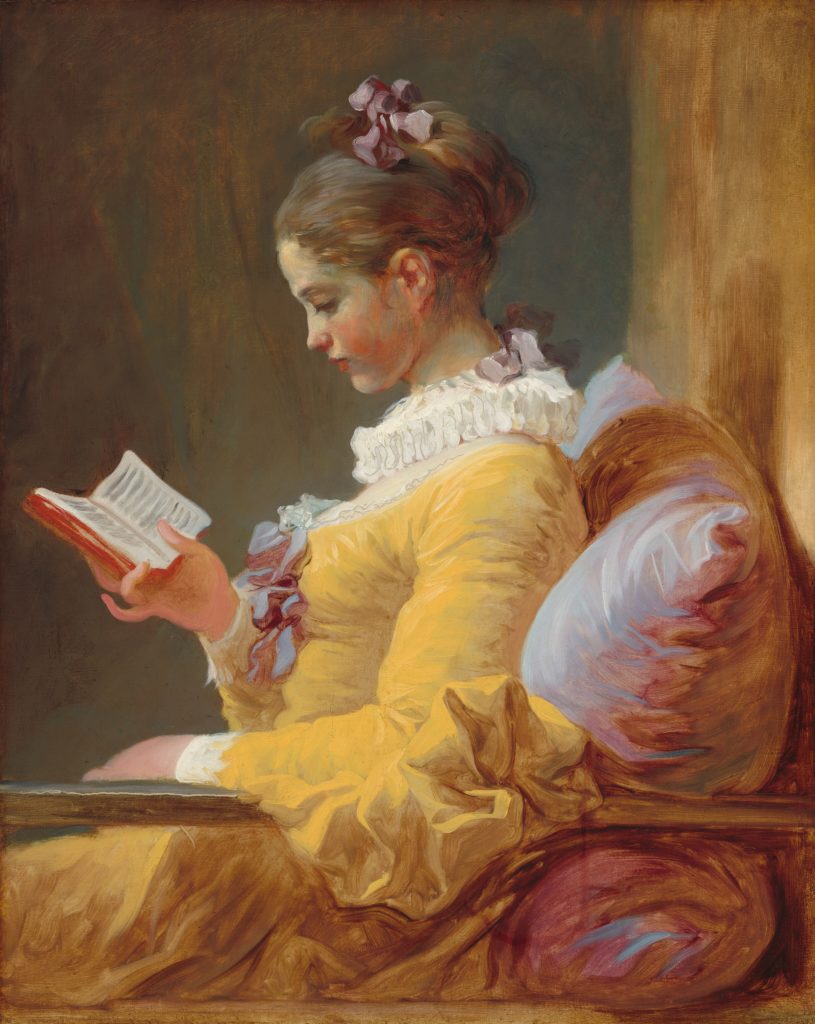
8. Fragonard, Young Girl Reading
Fragonard’s work is emblematic of the 18th century. The painter’s reputation rests on his love scenes and portraits.
Fragonard specialized in these popular genre scenes. But his works were also meditations on French society.
Young Girl Reading is one of the most famous Rococo period paintings in the United States. This beautiful painting depicts a young woman iin half length.
She’s wearing a brilliant lemon yellow dress. Fragonard paints a fine rendering of the dress folds. The girl is shown in profile intently reading a book.
Young Girl Reading is part of an ensemble of Fragonard paintings known as the “fantasy figures.” The paintings is emblematic of Fragonard’s expertise brushwork and color. These techniques would go on to influence the Impressionist painters.
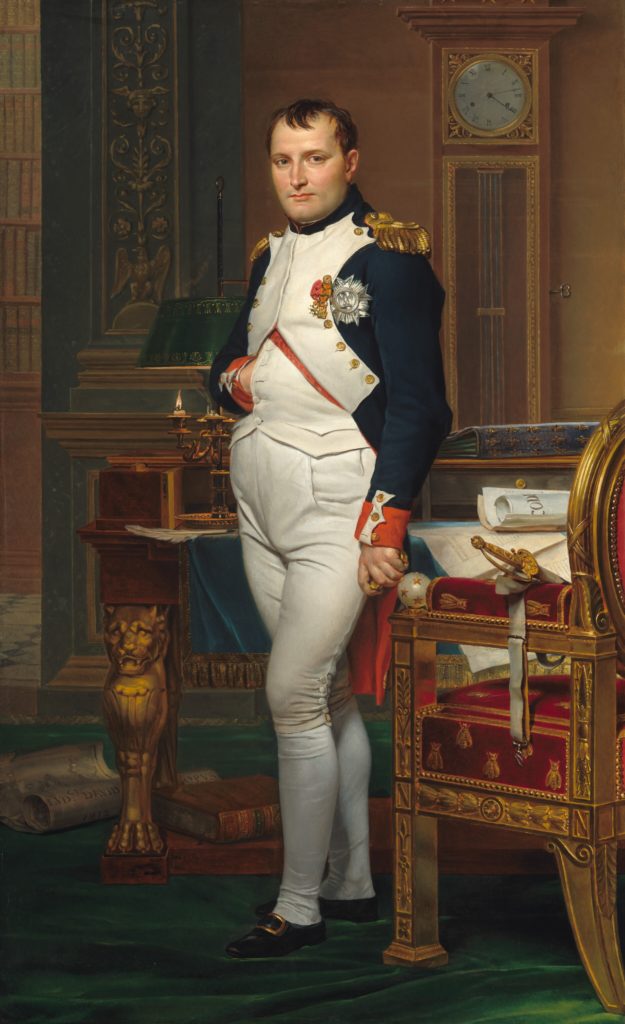
9. Jacques-Louis David, The Emperor Napoleon in His Study at the Tuileries
David was one of the quintessential painters of the Neo-Classical period. This period of art history rejected the extravagances of the Rococo period.
David’s canvases were monumental. His works were perhaps the pinnacle of traditional history painting.
David adopted the then fashionable Greco-Roman style. He mixed antiquity with Enlightenment philosophy, usually with the purpose of paintings that served as moral exemplars or propaganda statements.
In this imposing portrait of the emperor, Napoleon is show dressed in military attire. On his desk rests the Napoleonic Code, along with quills, papers, and an almost extinguished candle.
These devices portray the image of Napoleon as a hard working leader. He looks like a man dedicated to the well being of his subjects. David created a convincing appearance of Imperial power.
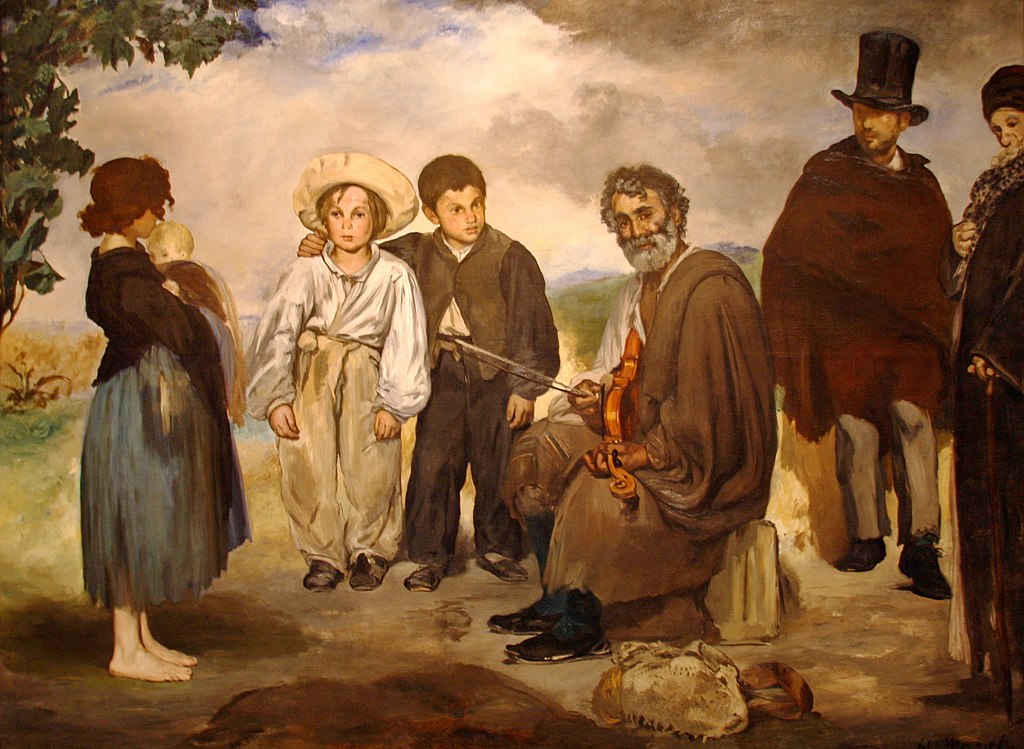
10. Edouard Manet, The Old Musician
Manet is one of my favorite 19th century painters. He was one of the first painters to adopt a decidedly modern style of painting.
Manet influenced and was a precursor to the Impressionists. He altered traditional realism by adding unconventional elements of subjects.
In this powerful scene, Manet depicts a motley group of seemingly random characters — a rag picker, gypsy children, a baby, and a musician. They are portrayed against a strange, abstract, and unidentified background.
Manet thus depicts ordinary men and woman on a grand scale. Such a rendering was usually reserved for the upper class.
The painting’s meaning is indecipherable. It’s possible it was a social commentary on the Parisians that were dispossessed during the Haussmann renovations of Paris.
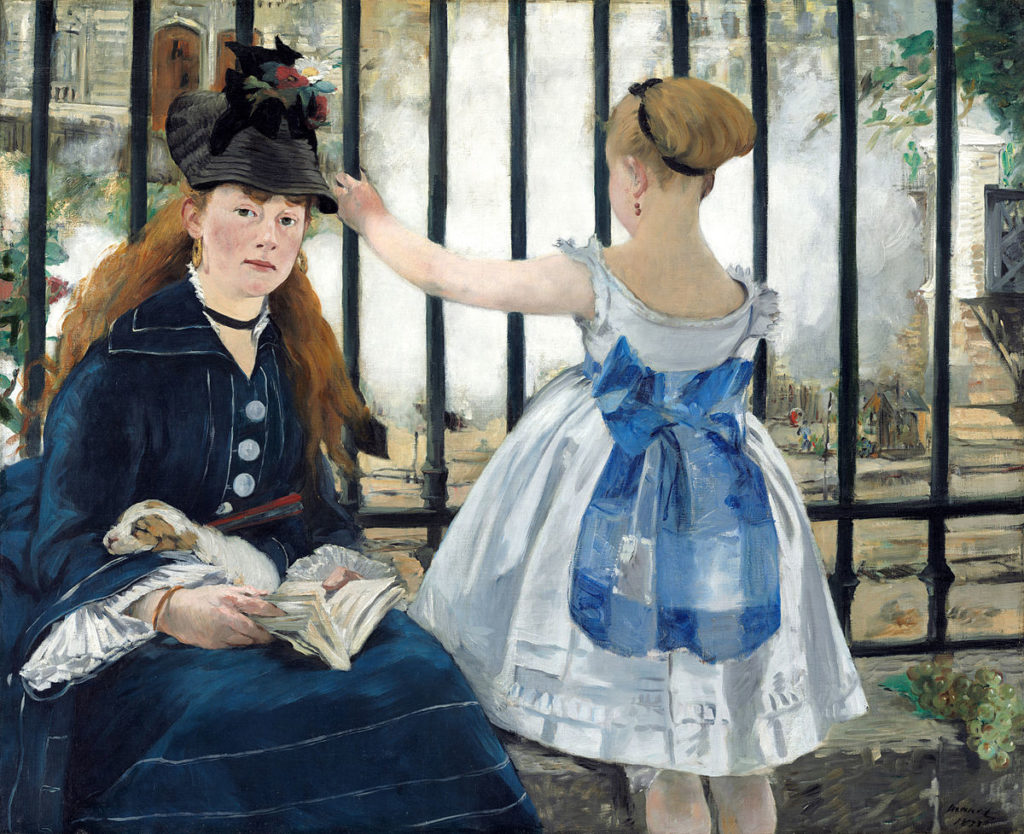
11. Edouard Manet, The Railway
This beautiful painting is enigmatic, which is a hallmark of Manet’s art. The focus is a young woman and a young girl.
They’re clad in contrasting colors. The young girl glimpses through the bars. Behind that are the tracks of the Gare Saint Lazare, the busiest railway station in Paris.
Although the girl looks throughs the bars, all the viewer sees is billowing white steam. This reflect Manet’s unconventional approach to narrative.
The painting is titled The Railway. But the viewer doesn’t actually see the subject.
This was a rare Manet painting accepted by the salon. Though it was still criticized as unfinished.
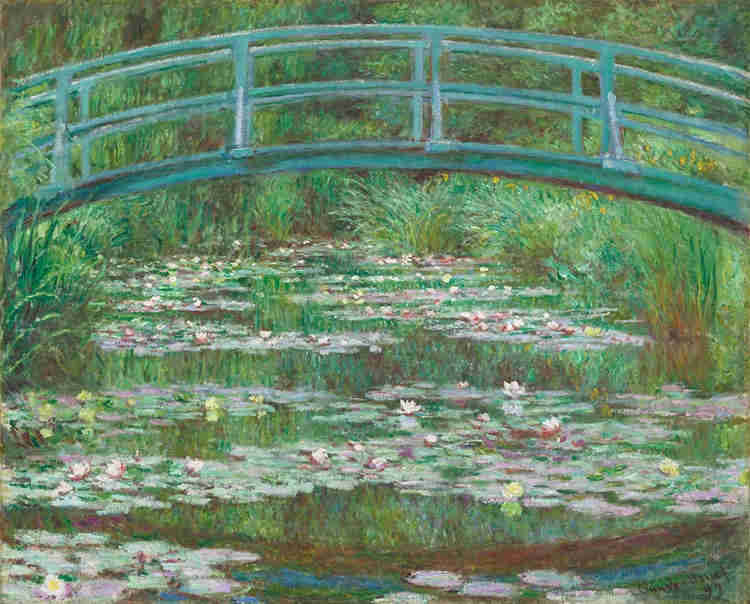
10. Claude Monet, Japanese Footbridge
Claude Monet was the founding father of Impressionism. Unlike prior artists, the Impressionists rebelled against the rigid rules of the hierarchic and tyrannical art establishment.
The Impressionists painted outside. They aimed to capture the ephemeral, sensory effect of a leisurely scene — the impression that objects made on the eye in a fleeting instant. The Impressionists used fast and loose brushwork, a lighter palette, and tried to capture the effects of light.
In 1883, Monet left behind the urban life of Paris. He moved to the rural town of Giverny in Normandy.
There, Monet created one of the world’s most beautiful and popular gardens. It was a one of a kind pastoral paradise, born from a great artist’s obsession with water lilies.
READ: Guide To Monet’s House and Gardens in Giverny
The pond in Monet’s garden was adorned with an adorable humpbacked Japanese-style bridge, which is the subject of this NGA painting. It was the centerpiece of the garden. Monet was influenced by Japanese woodblocks, in vogue at the time.
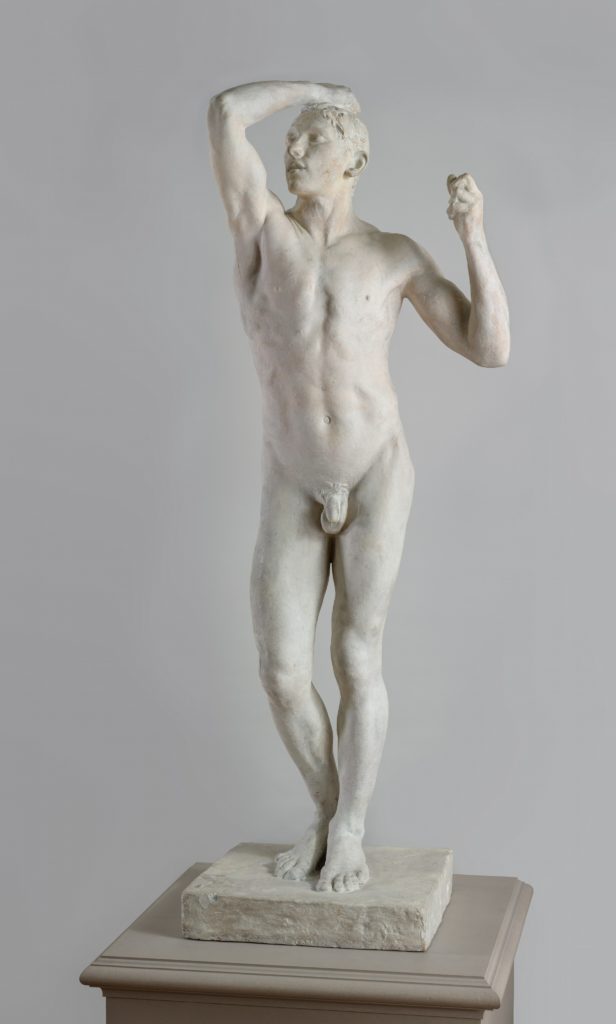
11. Auguste Rodin, The Age of Bronze
Rodin is considered the father of modern sculpture. He was absurdly talented. His works were a torrent of expressive power.
Rodin’s first breakthrough came in 1877 with the exhibition of The Age of Bronze at the Paris Salon (initially titled The Vanquished).
It’s a life size statue of an emotional man in a moment of awakening. The sculpture was technically perfect and remarkably naturalistic.
It was so perfect that, when it was first exhibited, the sculpture sparked a critical scandal. Rodin was publicly accused of casting the statue from an actual model or corpse.
The Age of Bronze was replicated in many materials. The NGA’s version is an 1898 casting in marble.
The NGA also owns some other Rodin sculptures, including a smaller bronze version of The Age of Bronze and a bronze The Thinker.
READ: Guide To the Rodin Museum in Paris
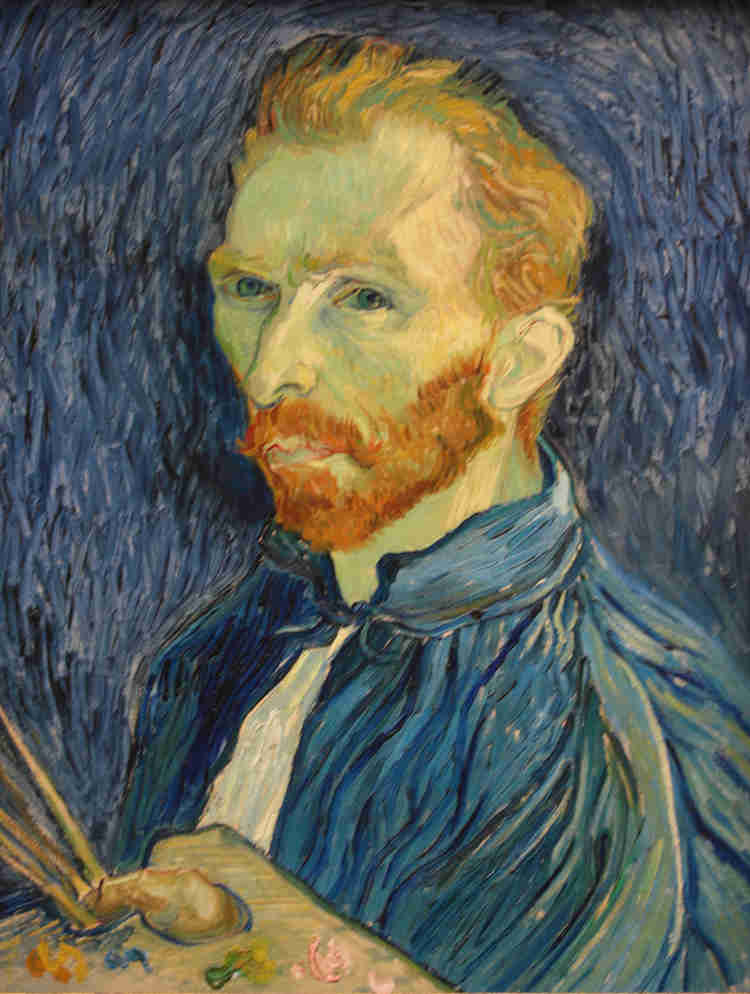
12. Vincent Van Gogh, Self Portrait
Van Gogh was a Dutch Post-Impressionism artist. He spent most of his life in France.
He failed to sell a single painting in his lifetime. He was the stereotypical tortured artist. He died penniless under suspicious circumstances.
But Van Gogh was rediscovered posthumously. He’s now considered one of the greatest and most influential painters in art history.
Van Gogh painted over 43 self portraits. The one in the NGA is one of his finest. It was painted when Van Gogh was in an asylum in the town of St. Remy in Provence.
The background of the painting is filled with waves and spirals. The painting has tense brushstrokes. The dominant colors are dark blue and vivid orange.
Van Gogh’s features are gaunt, grizzled, and tormented. Van Gogh himself is immobile. But everything else in the painting is like an undulating force field.
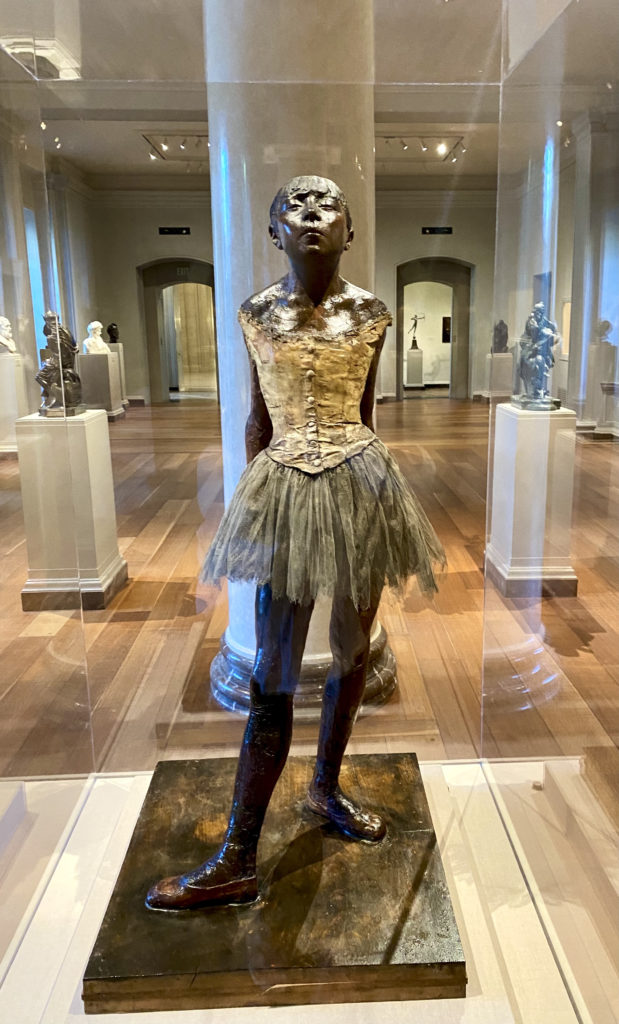
13. Degas, Little Dancer Aged 14
There’s a large number of Degas works on display at the NGA, including both paintings and sculptures. In fact, the NGA has the world’s largest collection of Degas’ wax figures.
This famous wax statuette is a multimedia work. The sculpture is covered with beeswax, clay, metal, human hare, a ribbon, and a muslim tutu. This is the only three dimensional work that Degas ever created.
When it was displayed, it caused a scandal. Viewers were used to classical or heroic renderings of idealized figures, not a depiction of a working class “Opera rat.”
The sculpture is now adored now. But at the time, it was deemed an ugly anthropological specimen.
Degas never exhibited the Little Dancer subject again. It was rediscovered in the artist’s studio after his death in 1917.
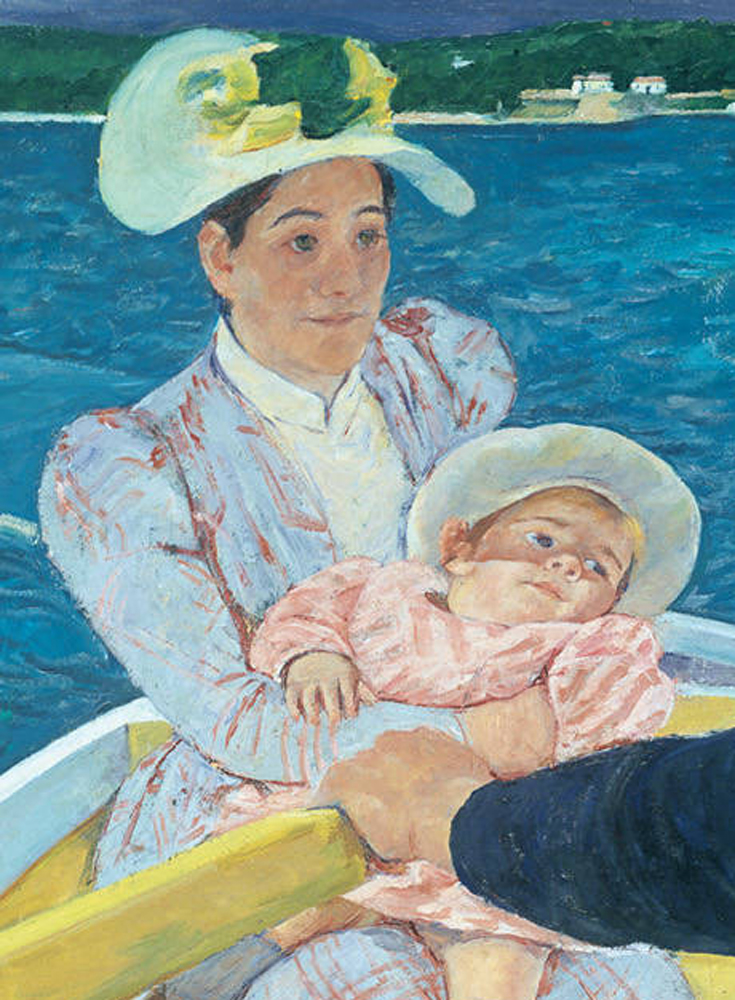
14. Mary Cassatt, The Boating Party
Mary Cassatt was one of the only women in the Impressionist group. But she was supremely talented.
The Boating Party is one of her most ambitious works. It was the centerpiece of her first solo exhibitor in the United States.
The composition is bold. Like Monet’s works, it reflects the influence of Japanese prints, which were in vogue then.
The color is simplified, laid on a flat surface. The shapes are almost abstract.
This change in Cassatt’s style took her away from Impressionism. It moved her more into the Post-Impressionist (Van Gogh, Gauguin) camp.


15. Monet, Rouen Cathedral Paintings
Monet was obsessed with the the magnificent Flamboyant Gothic cathedral in Rouen France. The cathedral became the subject of his most ambitious project of the 1890s.
Monet spent parts of 1892 and 1893 in Rouen. He visited during February-March-April when the light was best.
Monet painted 31 versions of the cathedral. Most were extreme close ups of the pale filigreed stone facade.
Sometimes he worked on 14 canvases at once. Monet groaned: “Everything changes, even stone.”
In each Monet canvas, the light is different depending on the time of day. The cathedral almost loses its objective identity as its bulk is translated into a heavily impastoed surface of misty color. The cathedral series was a watershed moment in Monet’s career.
The NGA has two of these magnificent images from 1894.
READ: Guide To the Monet Museums in Paris
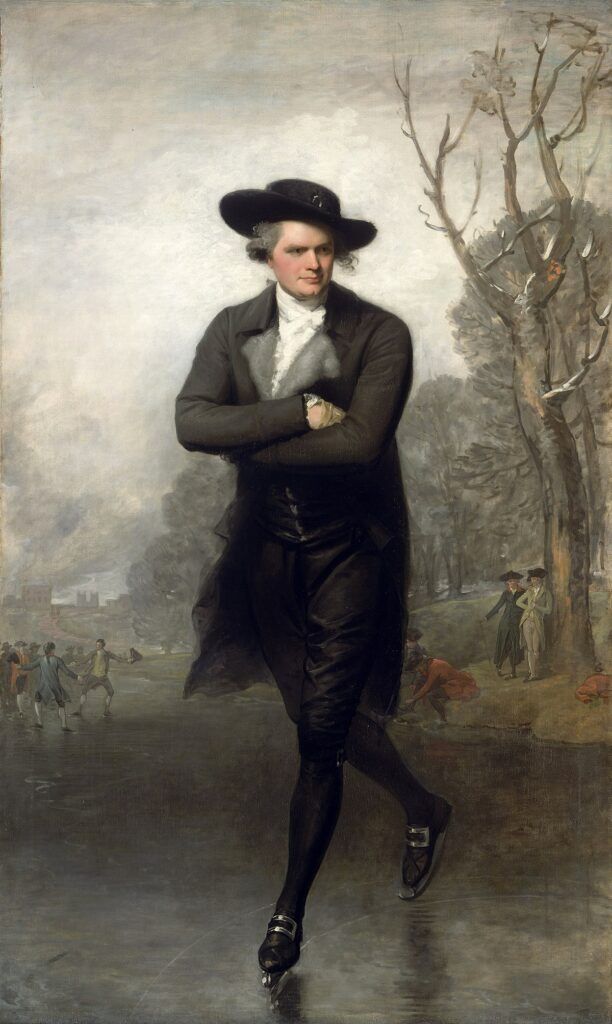
16. Gilbert Stuart, The Skater
Gilbert Stuart is an 18th century portraitist famous for his iconic paintings of George Washington created in Philadelphia.
But he first arrived on the European art scene with the painting The Skater. In it, he depicts William Grant skating on a pond.
Full-length “Grand Manner” style portraits from this time generally showed the subject standing still. So Stuart’s skating theme was novel. Grant stands in a position that mimics one of the world’s most famous statutes, Apollo Belvedere in the Vatican Museums.
Stuart’s work has a graceful and silvery look. It’s reminiscent of Gainsborough and perhaps anticipated the gray harmonies of Whistler’s Mother by 90 years.
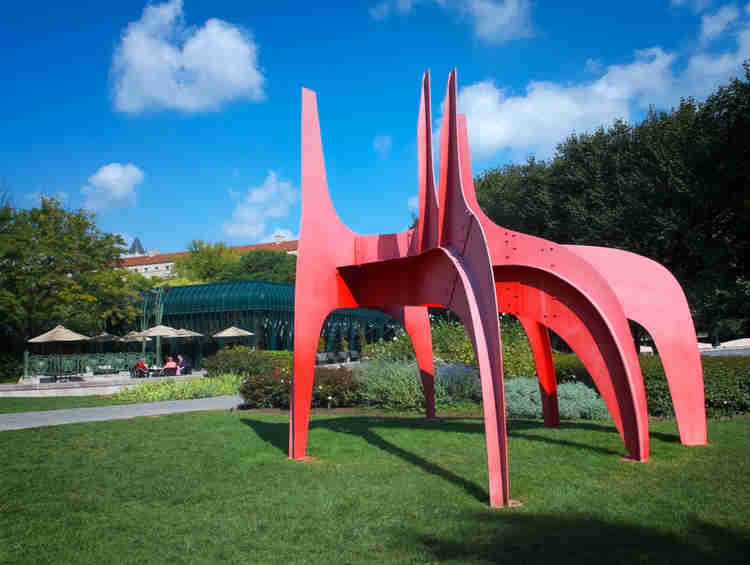
NGA Sculpture Garden
The NGA also has a free Sculpture Garden. It’s a beautiful green 6 acre space.
Opened in 1999, the art park features 17 modern art sculptures set amid beautifully landscaped informal garden. In the center is an ice skating rink. There’s also a cafe.
The works on display are by renowned artists such as Louise Bourgeois, Mark di Suvero, Marc Chagall, Roy Lichtenstein, Claes Oldenburg, Coosje van Bruggen, and Tony Smith.
It’s not as incredible as the Hirshhorn Sculpture Garden, but definitely worth a look.
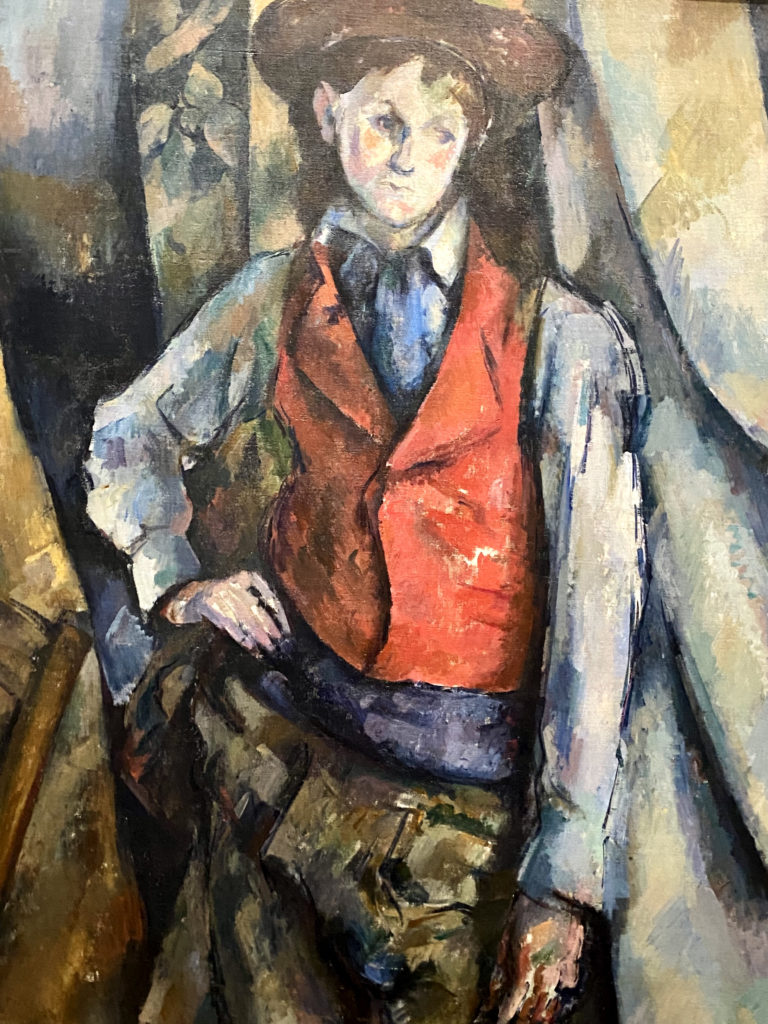
Practical Guide To Visiting the National Gallery
Need some tips for visiting the National Gallery of Art? Here’s all you need to know.
Address: The NGA is located at Constitution Ave. NW, Washington, DC 20565. The Sculpture Garden is on the National Mall at 7th Street and Constitution Avenue, NW, Washington, DC. It’s just across from the museum.
Hours: The museum is open Monday through Saturday from 10:00 a.m. to 5:00 p.m. and Sunday from 11:00 a.m. to 6:00 p.m. The Gallery is closed on December 25 and January 1.
Entry fee: The museum is free to enter.
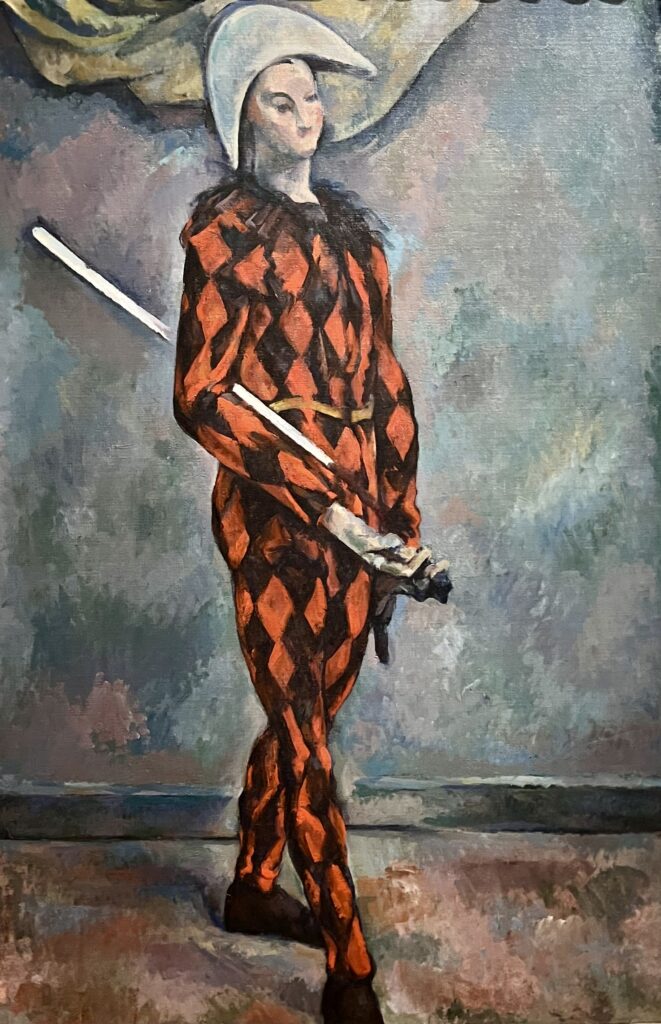
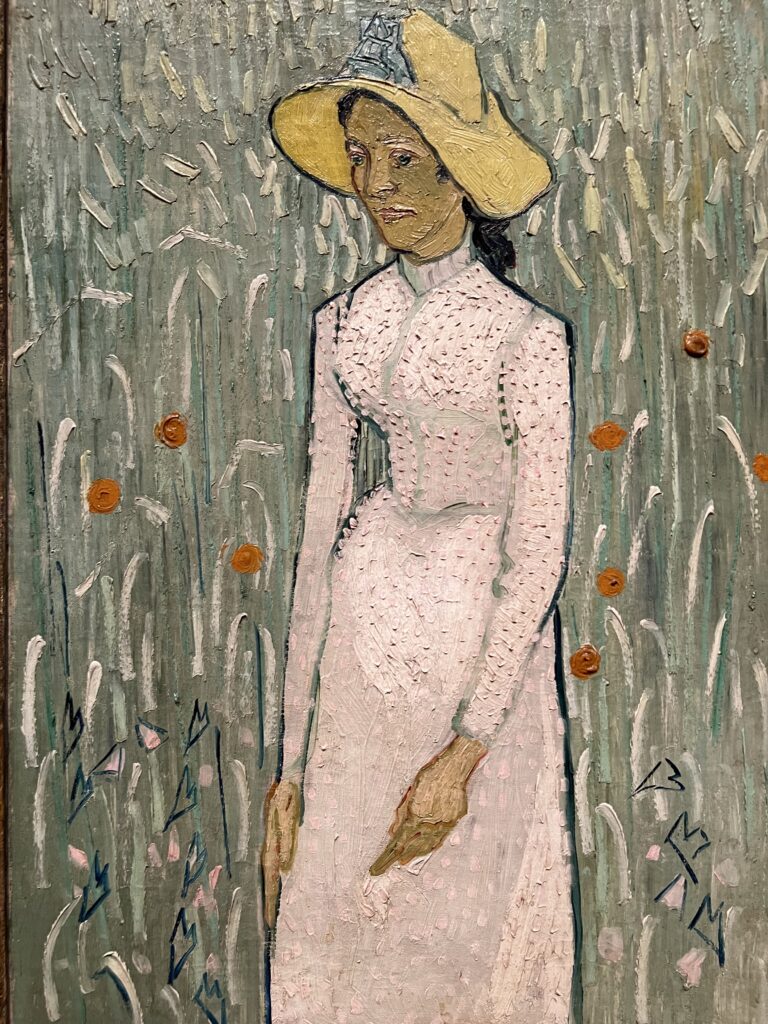
Tours:
If you’re an art lover, you may want to book a guided tour to see all the masterpieces.
The NGA also gives several free 60 minute tours. There’s a highlights tour at 1:00 am, an Italian Renaissance tour at 12:00 pm, a French Art tour at 3:00 pm, and a Breaking the Rules in Modern Art tour at 2:00 pm.
The first three tours leave from the Rotunda in the West Wing. The last one leaves from the Art Information Desk in the East Wing.
Metro: Red Line (Gallery Place), Blue/Orange Line (Archives), or Green/Yellow Line (Federal Triangle). It’s a short walk from any of these stations.
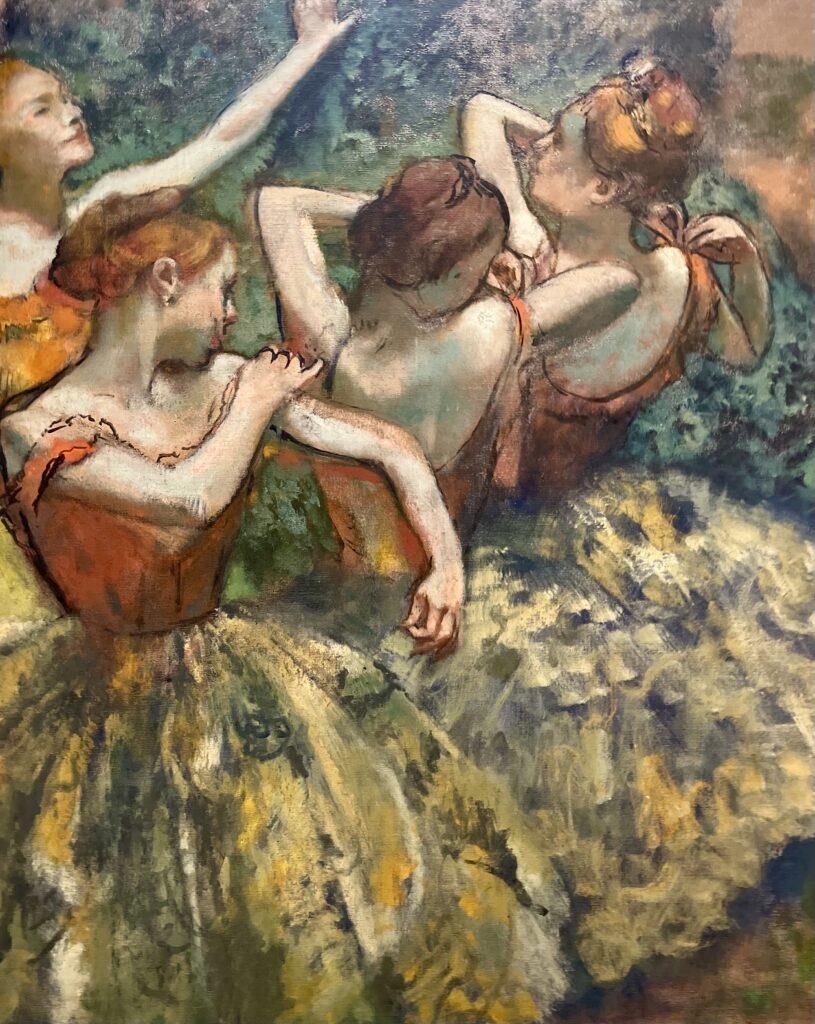
Pro tips: You can pick up a map when you enter. If you are pressed for time, choose the maps with either West Wing highlights or East Wing highlights.
Food: There are three cafes and a coffee bar to eat onsite. The Terrace Cafe is connected to the upper level galleries of the East Wing via a bridge.
How Long To Visit:
You won’t be able to see everything in one day. The NGA is a huge museum that rewards repeat visit.
The best course of action is to visit for two hours or so over the course of two days, which was what I did my last time in D.C.
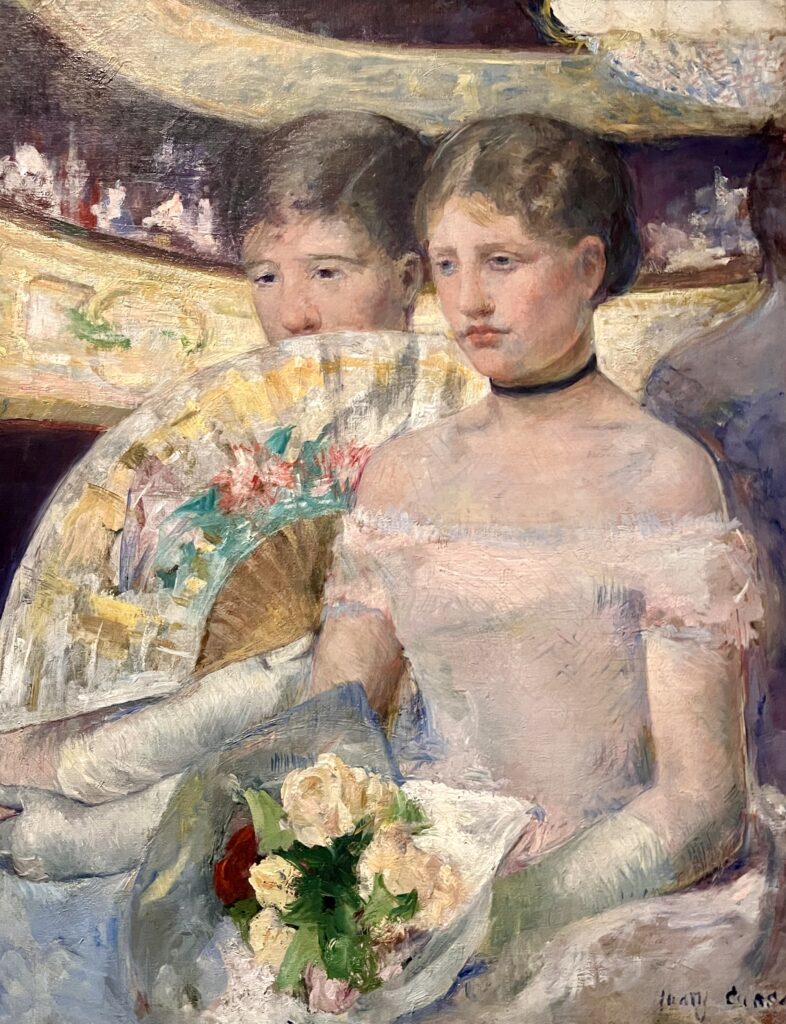
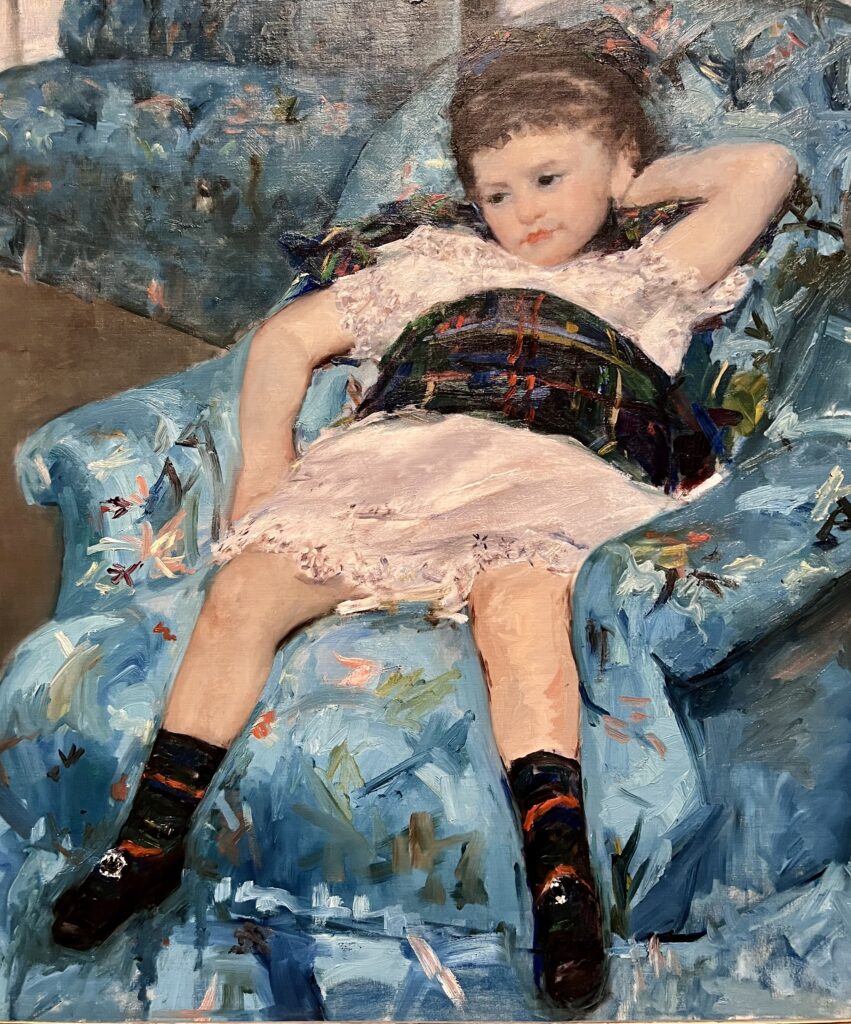
You may also want to choose between the East Wing and the West Wing. And you may want to identify the works of art you want to see and plan your visit accordingly.
READ: Expert Tips For Visiting A Museum
I hope you’ve enjoyed my guide to visiting the NGA and its top masterpieces. You may enjoy these other East Coast USA travel guides and resources:
- 25 most beautiful towns in New England
- United States Bucket List
- Fall foliage around Washington D.C.
- 2 days in Washington D.C. Itinerary
- 10 day itinerary for New Hampshire
- Hidden Gem Towns on the East Coast
- 10 day itinerary for coastal Maine
- 7-10 day itinerary for Vermont
- One week itinerary for southern New England
- Fall foliage road trip in New England
- Best places to visit in Massachusetts
If you’d like to visit the National Gallery in Washington D.C., pin it for later.

